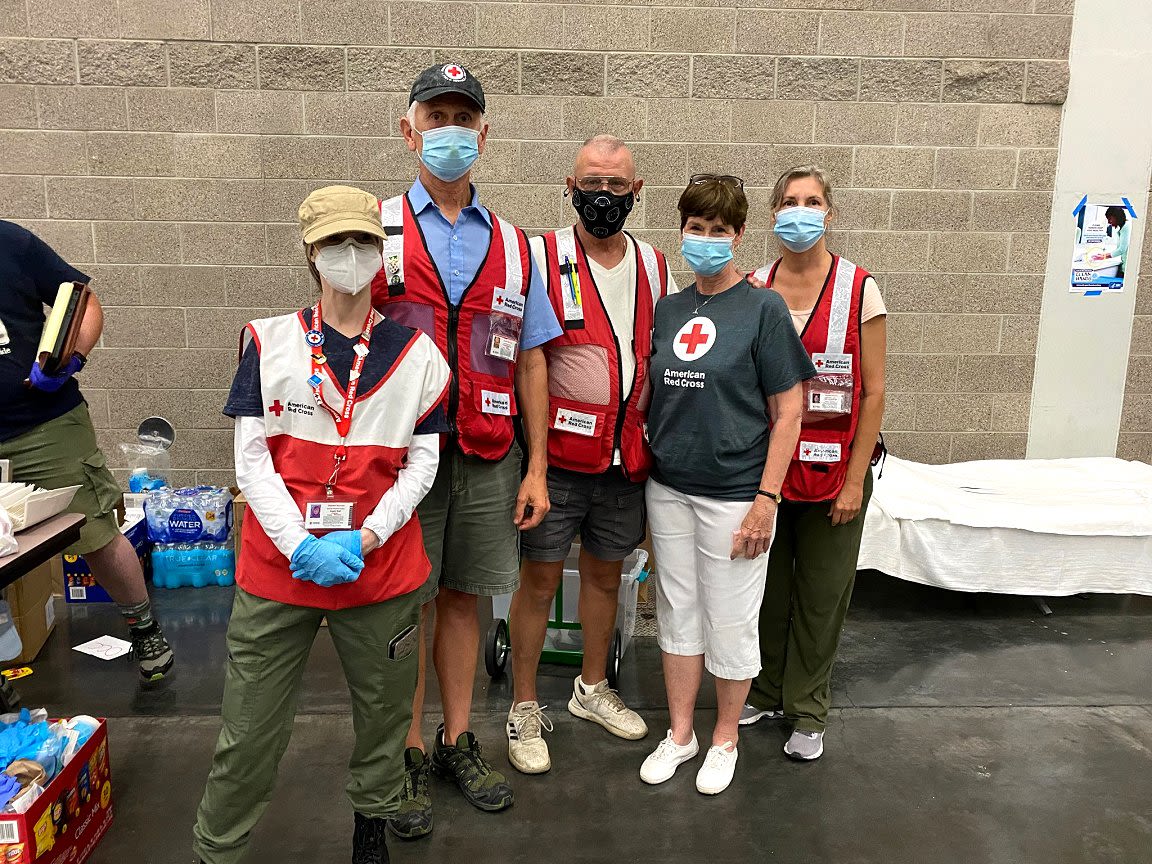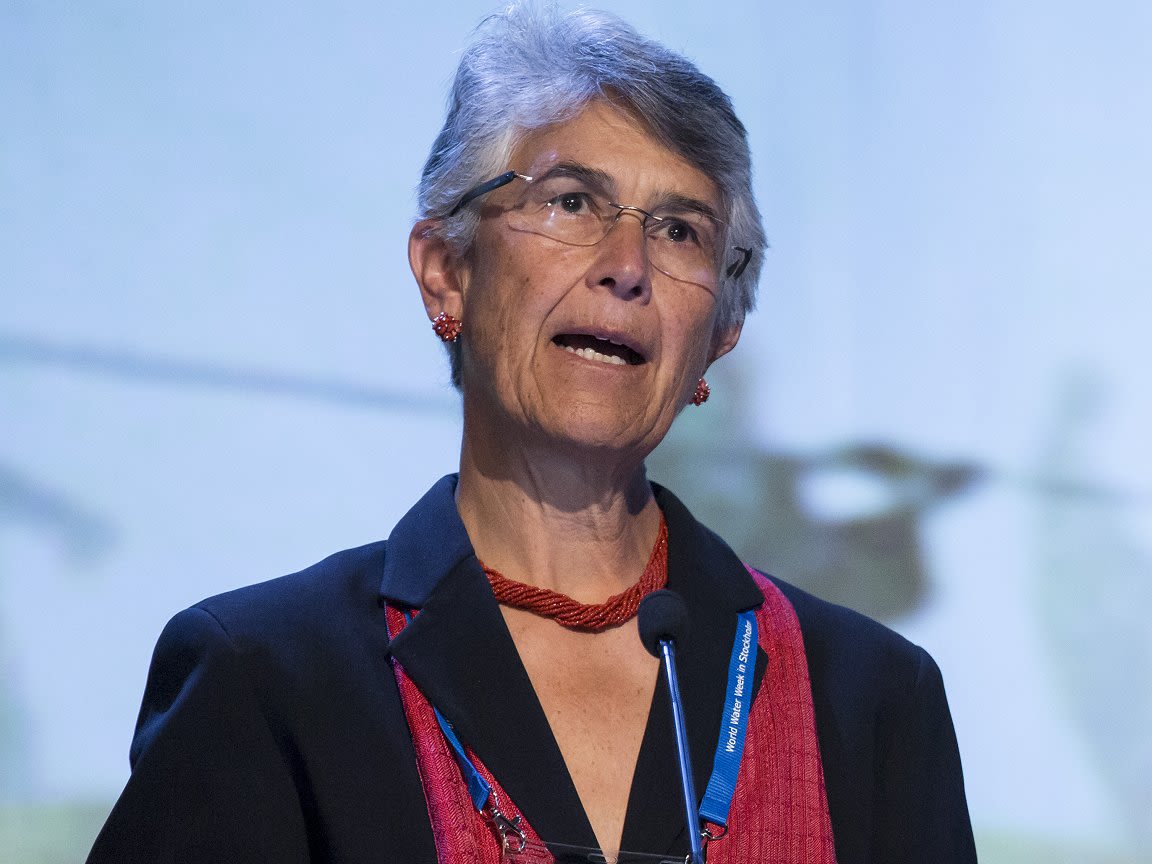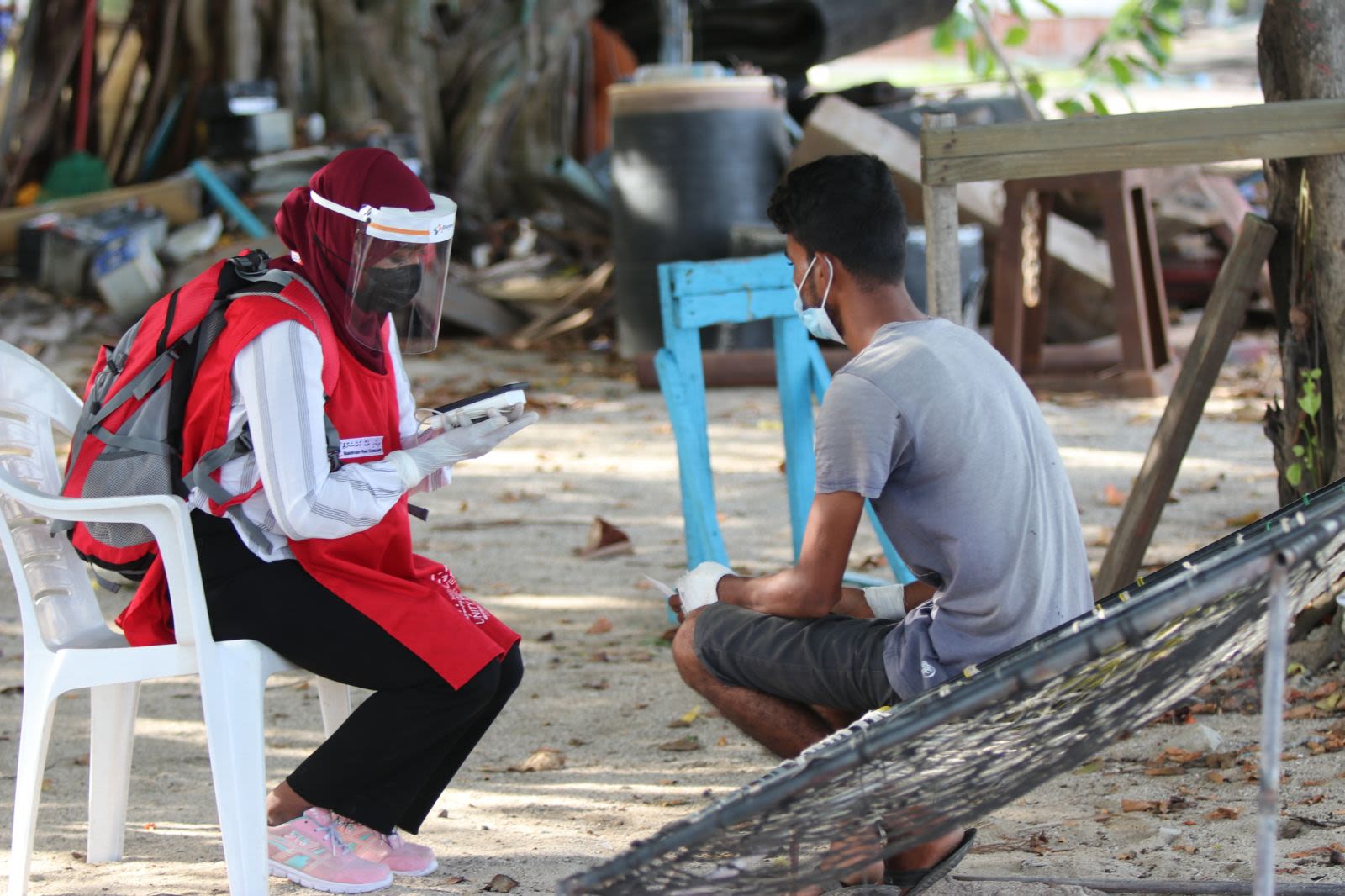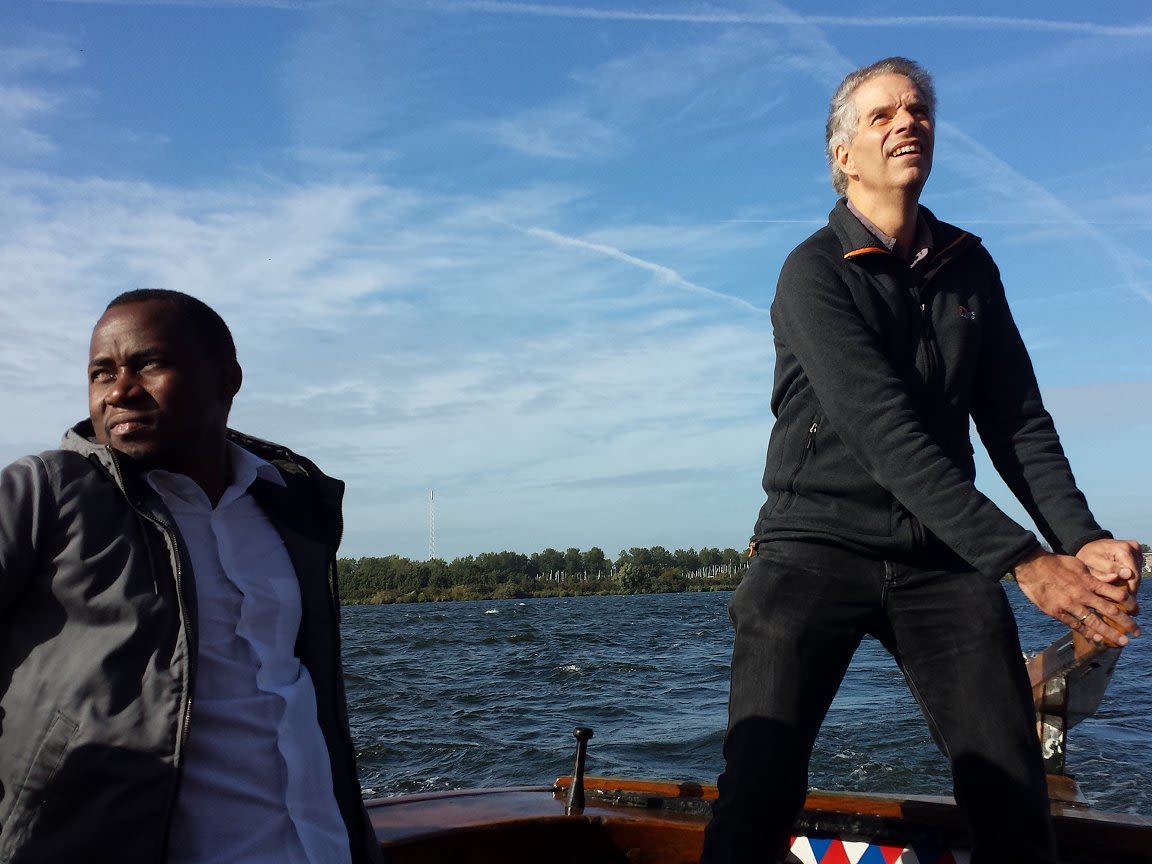Annual Report 2021
The three C’s: Covid, climate, conflict

PREFACE
Last year cutting edge science joined forces with public policy to roll back, if not defeat, a clear global threat. It was not climate change. The advent of vaccines enabled many societies in the developed world, at least, to edge back toward normality after nearly two years of the Covid-19 pandemic and lockdowns. But thanks to Covid, we do now have a slightly better idea of what a truly global response to climate change might look like.
As is often the case when we sit down to prepare our annual report in the early northern-hemisphere spring, it is very difficult to block out major events of the first few weeks of the year; never was this more true than two years ago, when country after country went into unprecedented lockdowns.
It is so again now, as the conflict in Ukraine dominates the headlines, the humanitarian sector, and the attention of governments and millions of people worldwide.
Of course, climate change is not the cause of this confict. But the ramifications certainly intersect with the climate crisis in many ways, reflecting the warnings about compound crises that the IPCC Working Group II report highlighted so clearly.
Even as our colleagues in the Ukrainian Red Cross and the ICRC strive to maintain humanitarian access, we are also struggling with aggravated humanitarian challenges globally – food-price inflation perhaps above all, reflected in the terrible hunger in the Horn of Africa; the record heatwave in South Asia that affected harvests and triggered an export ban in India has not helped matters.
At the same time, the new geopolitical outlook will also have implications for Net Zero as governments consider their energy futures and their commitments to the Paris goals.
American Red Cross volunteers at the Oregon Convention Center cooling station found themselves in uncharted waters with a historic heatwave. (Derek Reed/ARC)
American Red Cross volunteers at the Oregon Convention Center cooling station found themselves in uncharted waters with a historic heatwave. (Derek Reed/ARC)
Like Covid two years ago, the response to the war in Ukraine has shown what’s possible in terms of humanitarian action when governments, agencies and individuals act decisively in concert.
But also like Covid, the big question is whether we’ll step up and invest not only in response but also resilience, or enact short-term solutions, leaving the global system a more dangerous place in the face of rising risks.
In highlighting many positives from 2021 – the continued increase in attention for climate in our Red Cross Red Crescent network and the rolling out of the Climate and Environment Charter for Humanitarian Organizations, steady growth in anticipatory action, the first-ever youth-led climate summit, and small but important steps forward at COP26, including on adaptation and loss and damage – this report in no way seeks to play down the gravity of the humanitarian big-picture we currently face.
It is difficult to put pen to paper now without mentioning a key 2022 breakthrough for which much of the groundwork will have been done last year: for the first time the WGII report said clearly that climate change is already contributing to humanitarian crises in vulnerable contexts. Humanitarians have argued this for some time; they are no longer a lone voice. That is progress, and it underlines the urgency of our work in the years ahead.
by Yolanda Kakabadse and Maarten van Aalst
(At right: IFRC Secretary General Jagan Chapagain at the 11th European region conference in Tbilisi. ‘Three C’s are threatening us right now: Covid, climate change and conflict,’ he told the meeting.)
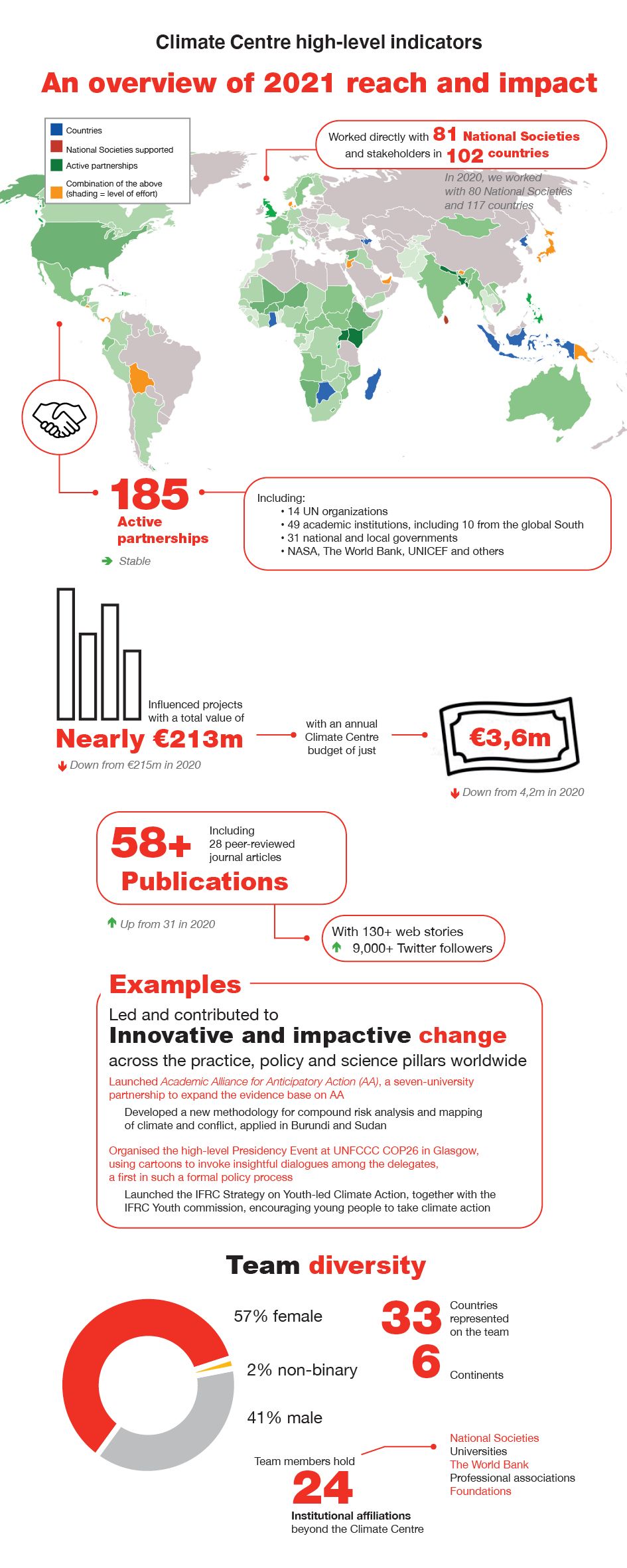
Climate Centre high-level indicators
Climate Centre high-level indicators
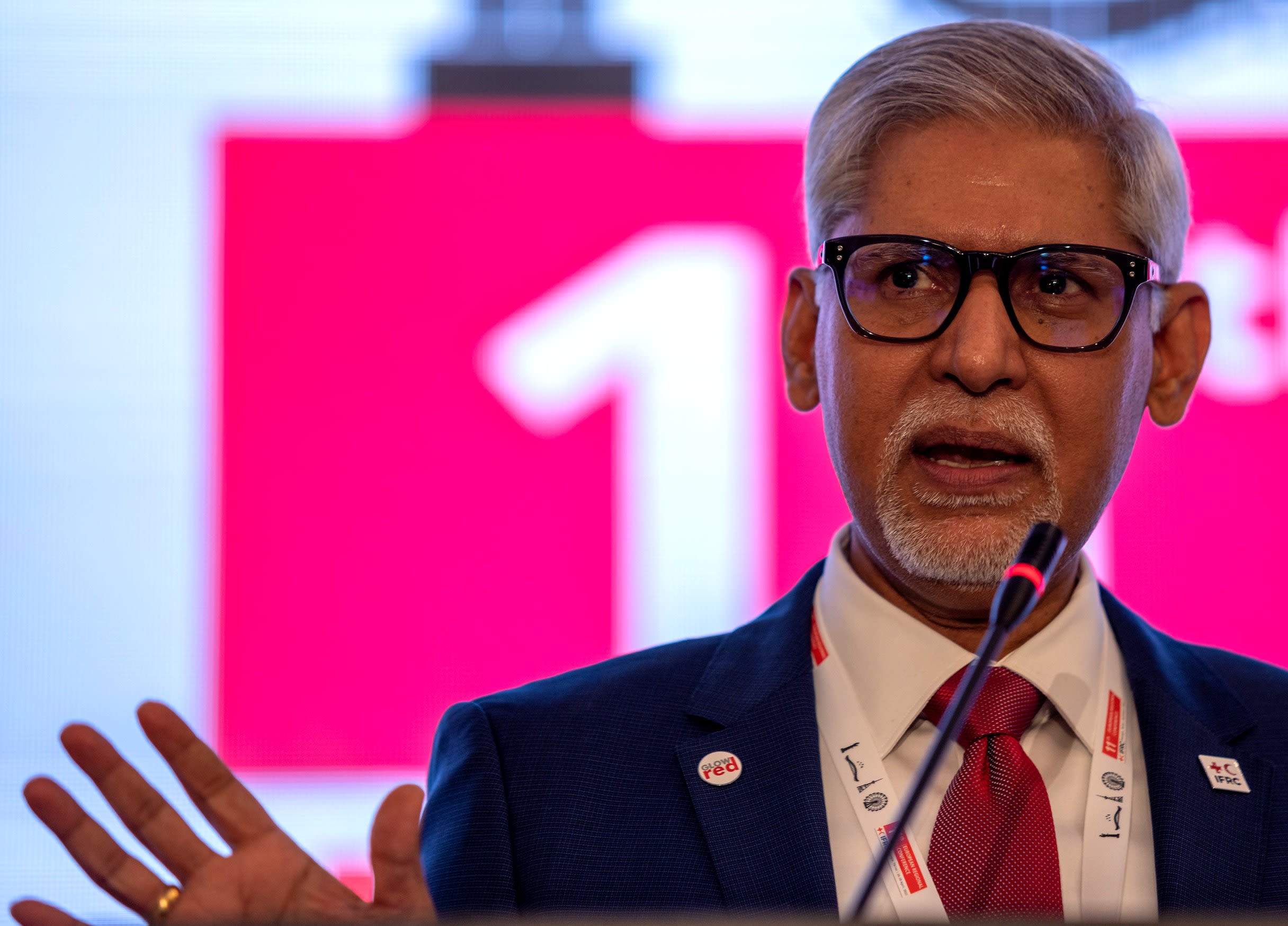
Policy
‘This report confirms our gravest humanitarian concerns about the climate crisis: many extremes we have been confronting around the world recently are part of a pattern, and we need to be ready for worse to come’
– Maarten van Aalst, Climate Centre Director and IPCC Coordinating Lead Author
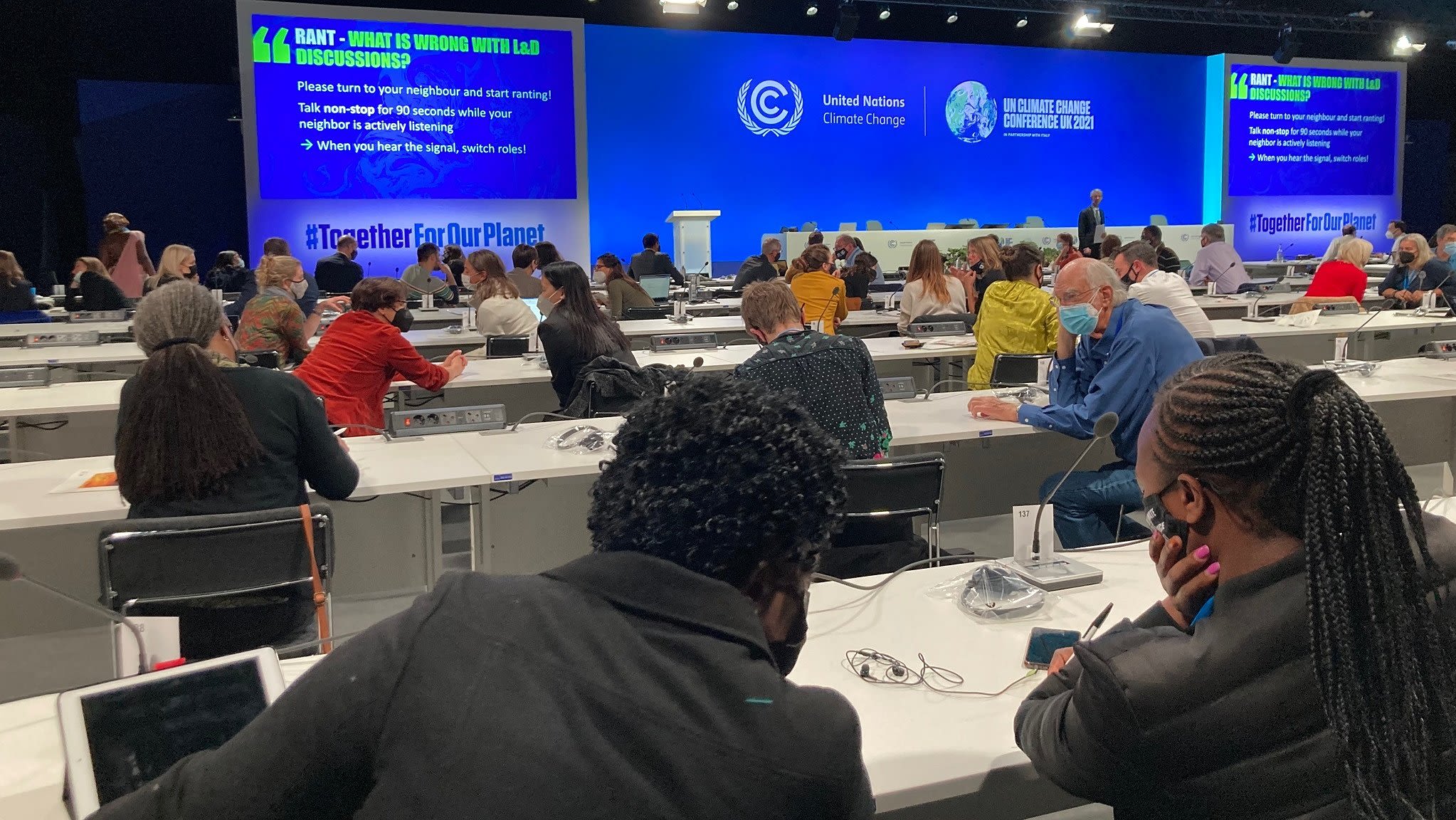
In the build-up to COP26, we jointly organized expert workshops on the four thematic areas identified by the UK presidency for the Climate and Development Ministerial held in March.
Aimed at driving a step change in ambition on adaptation and resilience, the workshops made space for partners in vulnerable countries to communicate their priorities and ideas on climate and development.
At the ministerial itself, attended by our director Maarten van Aalst, a new pathway document we contributed to acknowledged the need for progress, among other things, on climate finance and on loss and damage.
A highlight for us at the COP meeting in November came at a UK presidency flagship event on loss and damage designed by the Climate Centre and moderated by Maarten van Aalst (main photo). The Prime Minister of Barbados, Mia Mottley, told that session “there is no better measure that the world is still failing to understand the climate crisis than its failure to fund the mechanism for loss and damage.”
Yolanda Kakabadse, former Ecuador environment minister, took over from Ed Nijpels as chair of Climate Centre board in October. (Wikimedia)
Yolanda Kakabadse, former Ecuador environment minister, took over from Ed Nijpels as chair of Climate Centre board in October. (Wikimedia)
We led organization of the first-ever virtual Development and Climate Days alongside the COP. Over 1,000 people registered to take part in the event, breaking the previous attendance record set at COP23 in Bonn in 2017.
Prior to the UN climate talks in Glasgow, the Climate Centre was invited to deploy creative communications techniques to help negotiators identify actions on adaptation and loss and damage; examples included cartoons drawn in real time, a mock debate, and imagined future newspaper headlines.
We provided input to the IFRC report Displacement in a changing climate and co-authored a brief in support of the UNFCCC’s plan of action on loss and damage; this argued for strengthened social protection to minimize the impacts of, for example, desertification, rising sea-levels and lost biodiversity.
The Climate Centre convened at least 70 humanitarians and climate champions from the Red Cross Red Crescent Movement, the UN and other partners to help the IFRC Asia Pacific region develop support for National Societies engaging with National Adaptation Plans (the NS4NAP programme).
In response to a request for from Uganda’s Ministry of Water and Environment, we held workshops for civil servants and others on ways of assessing resilience, supporting development of the adaptation component of Uganda’s nationally determined contribution.
Anticipatory action
‘We need to invest now in preparedness to mitigate future protection needs and prevent displacement. Waiting for disaster to strike is not an option’
– UN High Commissioner for Refugees Filippo Grandi
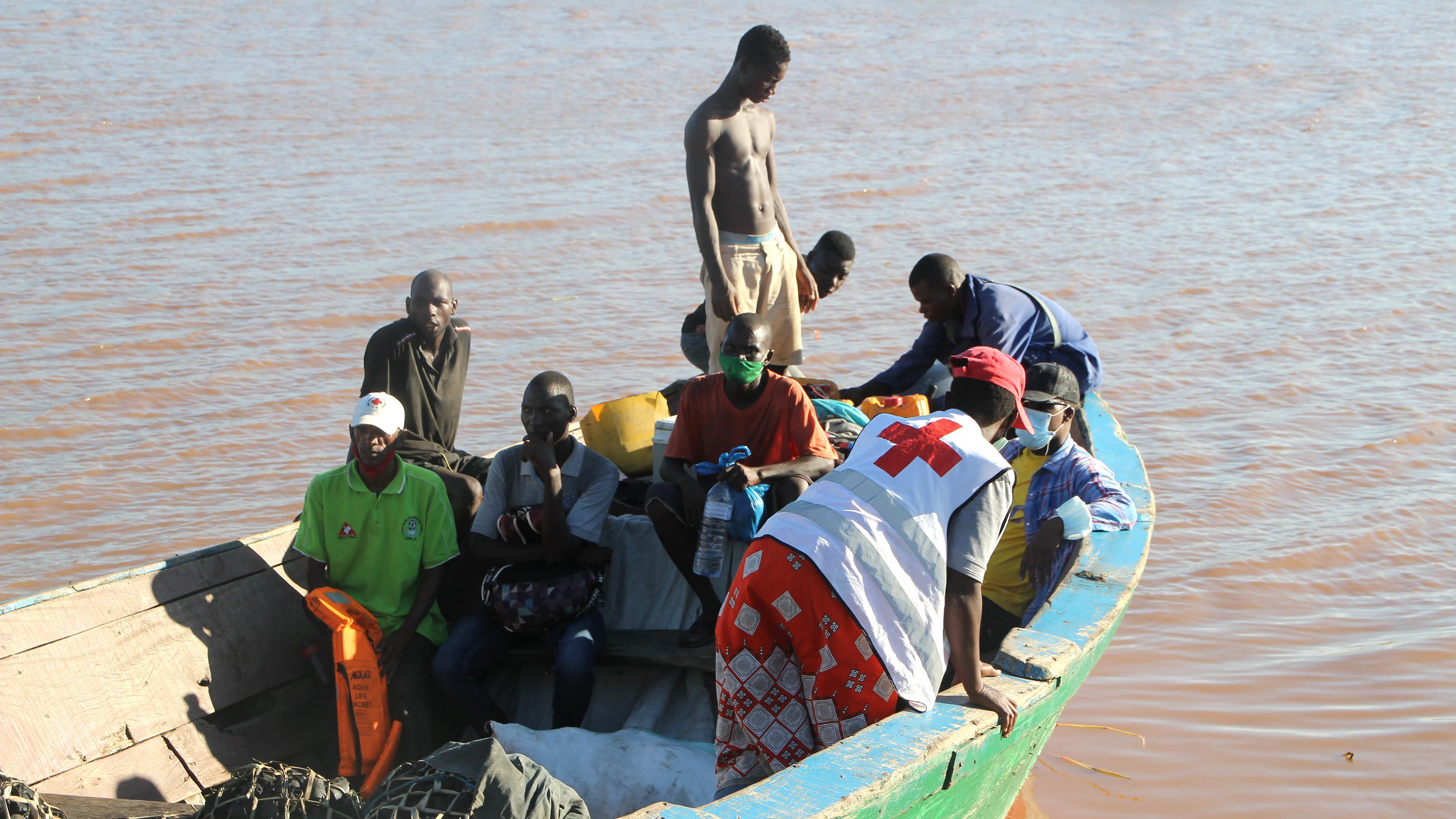
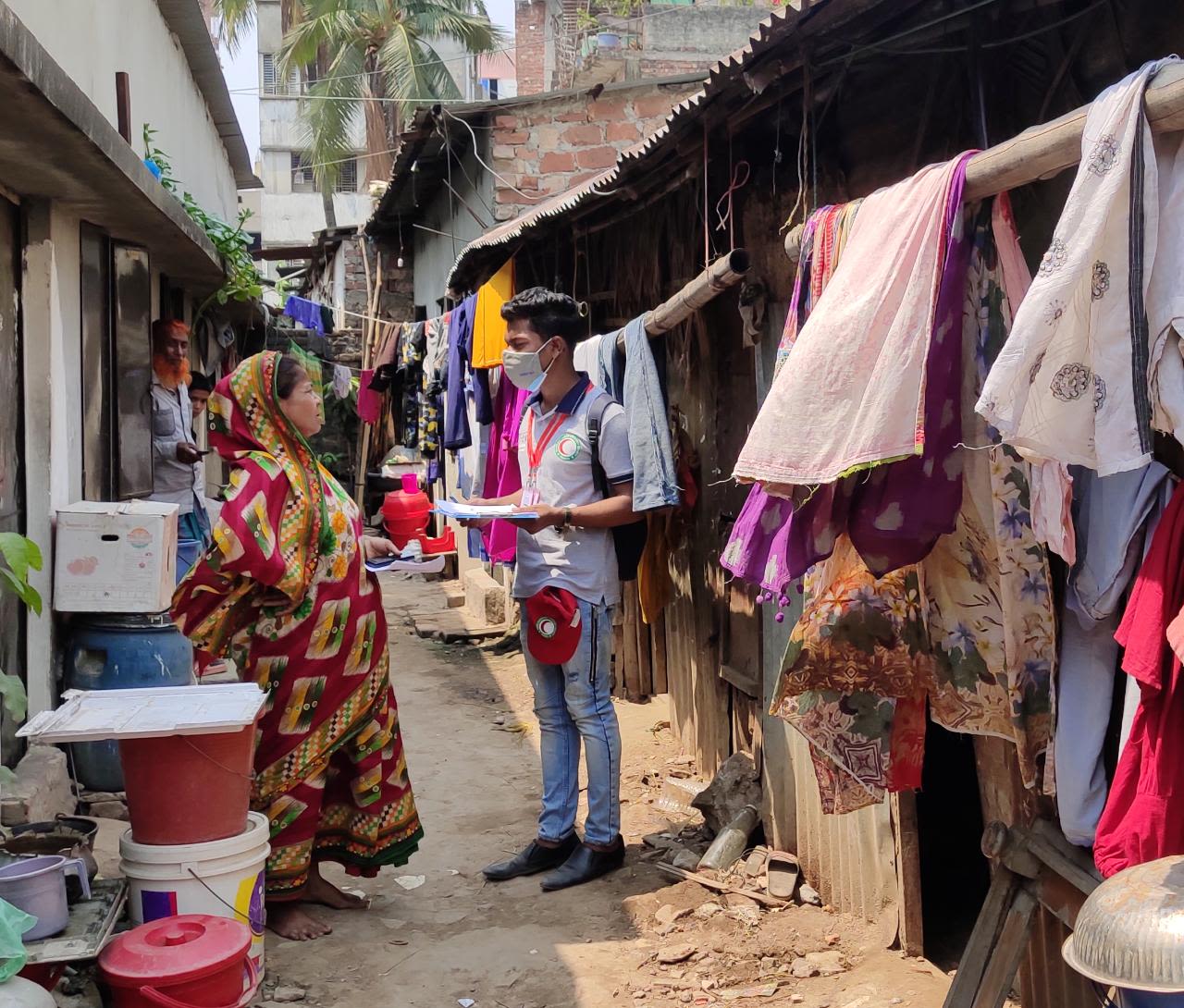
Bangladesh Red Crescent volunteers conduct interviews for a feasibility study on anticipatory action for heatwaves. (Bangladesh Red Crescent-German Red Cross)
Bangladesh Red Crescent volunteers conduct interviews for a feasibility study on anticipatory action for heatwaves. (Bangladesh Red Crescent-German Red Cross)
Last year witnessed continued compound risks from Covid, extreme weather and conflict, drawing further attention towards the need to scale up anticipatory action within and beyond the Movement.
Ten new early action protocols were issued in 2021 for access to forecast-based financing (FbF) from the IFRC’s Disaster Relief Emergency Fund (DREF): for floods in Bangladesh (and cyclones there), Ethiopia, Kenya, the Philippines and Uganda; heatwaves in Kyrgyzstan, Tajikistan and Vietnam; and drought in Niger.
With the support of the German Red Cross, the Mozambique Red Cross (CVM) took local early action ahead of Cyclone Eloise’s expected landfall in the vicinity of Beira, the same area hit by Chalane in December 2020, although Eloise did not meet the trigger specified in the relevant early action protocol; two CVM advance teams prepared an emergency response in shelter, water and sanitation, and health.
The Anticipation Hub launched its strategy for the next three years. The hub – an initiative of the IFRC, German Red Cross and the Climate Centre – saw growth of its membership to include partners such as the UK Foreign, Commonwealth and Development Office, bringing the total to nearly 100 from nearly 40 countries.
The Climate Centre contributed to the development of the IPCC Working Group I report on science with a cartoon-infused brief on the findings on anticipatory action.

Bangladesh Red Crescent volunteers conduct interviews for a feasibility study on anticipatory action for heatwaves. (Bangladesh Red Crescent-German Red Cross)
With the Anticipation Hub, we participated in the Planet:RED Summit organized by IFRC and ICRC, at which Liz Stephens – who joined the Climate Centre last year – argued for the need for investments in forecasting systems for early action to support the most vulnerable.
The World Meteorological Organization launched its guide to impact-based forecasting and weather services at the 9th Global Dialogue Platform on Anticipatory Humanitarian Action. It reflects advocacy and technical discussions by the Climate Centre – working closely with the WMO, the UK Met Office and national hydrometeorological services – to include a humanitarian perspective.
Among other outputs linking science to practice, we co-authored articles on Earth observations for forecast-based financing and redefining El Niño and La Niña.
In 2021, the Green Climate Fund approved a project worth nearly US$ 22 million to address an urgent need for better climate information services and multi-hazard early warning in Timor Leste; the Climate Centre will provide technical support on the development of FbF there.
Urban
‘The frequency and intensity of heat is expected to rise further in most land regions [and is] most acutely felt in cities’
– 2021 IFRC-Climate Centre brief, Reducing the health and water, sanitation and hygiene (WASH) impacts of climate change
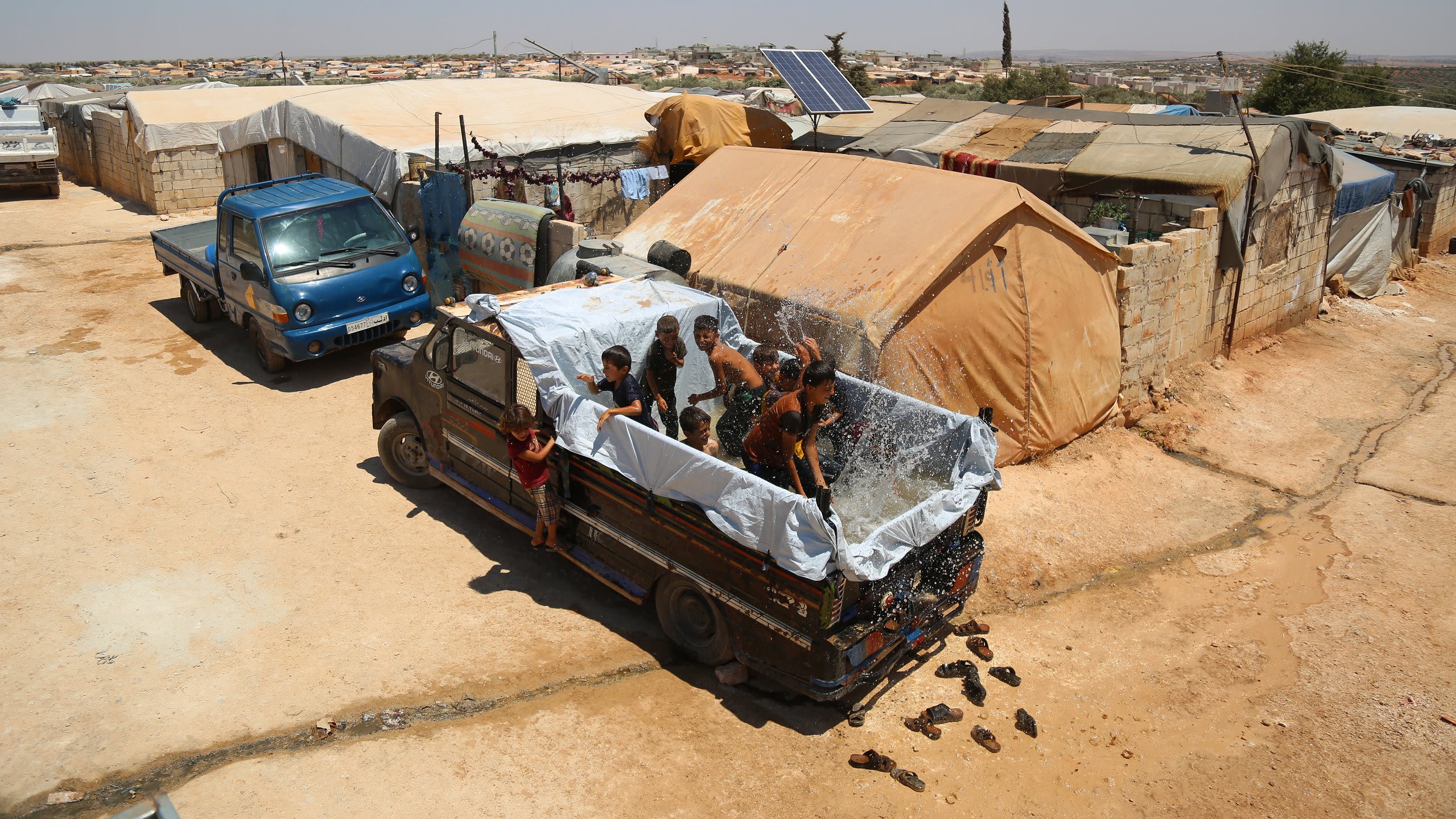
The Climate Centre introduced its low-cost, do-it-yourself guide to urban resilience in the shape of its Urban Action Kit at the 7th Humanitarian Networks and Partnerships Weeks last year. It was developed in 12 languages, a substantial expansion from the initial version in three languages in December 2020.
The next phase of our flagship urban programme in Southern Africa, FRACTAL, concluded with a ‘mega lab’ where delegates across the project exchanged insights and lessons learned.
Nine principles for encouraging a context-driven, inclusive and proactive approach to planning for climate risk in Southern African cities were developed. It’s hoped that city governments and stakeholders will use them to foster a collaborative approach.
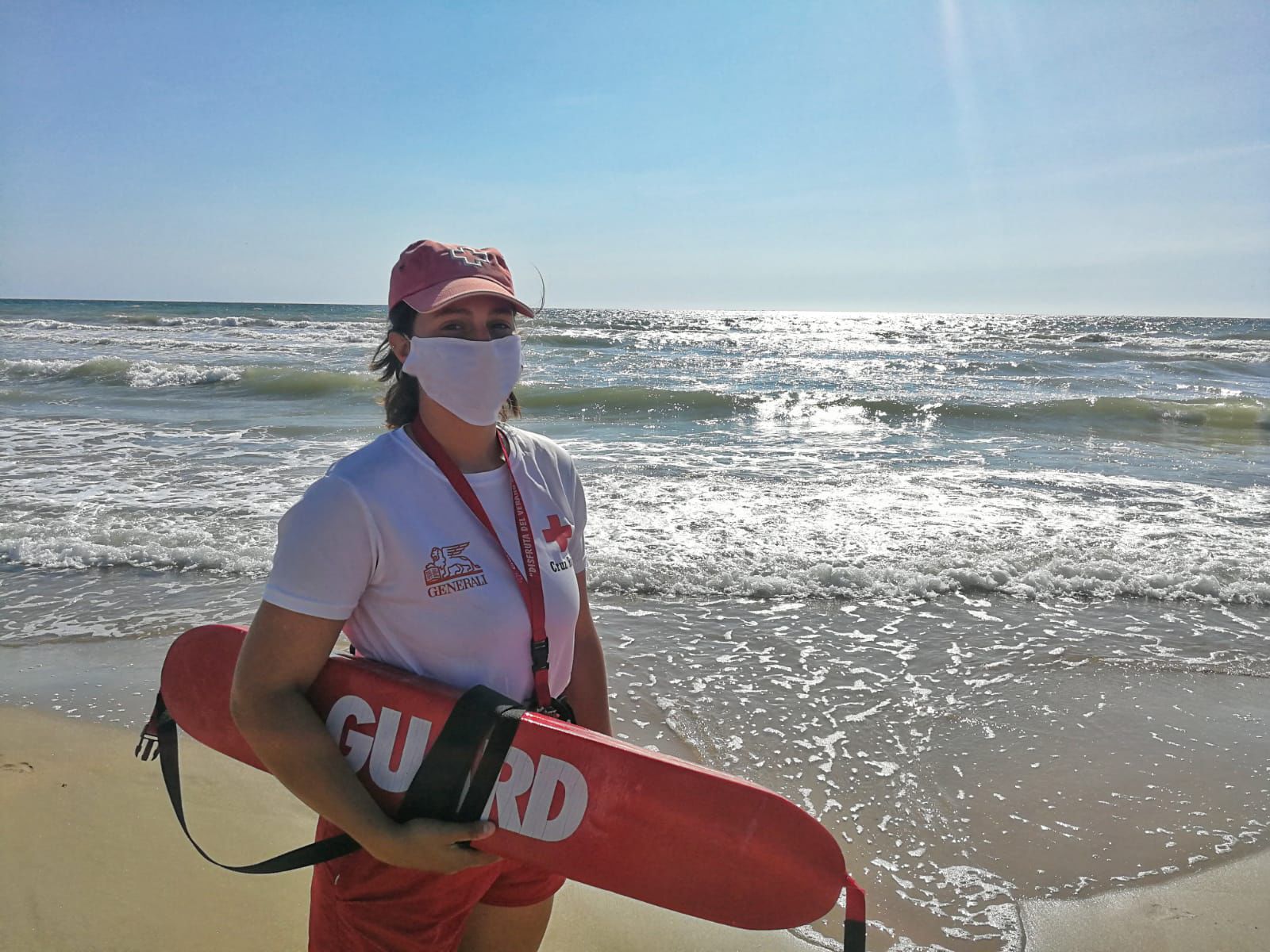
Spanish Red Cross volunteers patrolled deserted beaches as countries across Europe prepared for a dangerous heatwave in mid-June. (CRE)
Turning the Tide, a report on coastal risks in Bangladesh, Mexico and Somalia, developed jointly by the Norwegian Red Cross and the three National Societies, was launched at COP26.
The Climate Centre helped organize the IFRC’s Urban Collaboration Platform and ICLEI’s Rise Africa events, supporting both with cartoons drawn in real time to capture key insights.
Urban adaptation sessions were also integrated into the African Climate Fellowship programme and the Africa dialogue platform.
The Climate Centre jointly organized virtual events on heat, including the South Asia Regional Workshop on Heatwave Risks and Impacts, and a session at COP26 called Hot Hot Hot: How can cities adapt to rising heat?
We also produced a variety of new outreach materials tailored to South Asia, South-East Asia and Sub-Saharan Africa, including posters, social media graphics and videos.
A British Red Cross report, Feeling the heat, drew on Climate Centre research and offered health advice for heatwaves.

Spanish Red Cross volunteers patrolled deserted beaches as countries across Europe prepared for a dangerous heatwave in mid-June. (CRE)
Spanish Red Cross volunteers patrolled deserted beaches as countries across Europe prepared for a dangerous heatwave in mid-June. (CRE)
Health
‘Country assessments ‘on linkages between climate and health and livelihoods are something new and will contribute a wealth of knowledge and understanding for our work on resilience’
– Juan Daniel Reyes, Finnish Red Cross Asia-Pacific representative
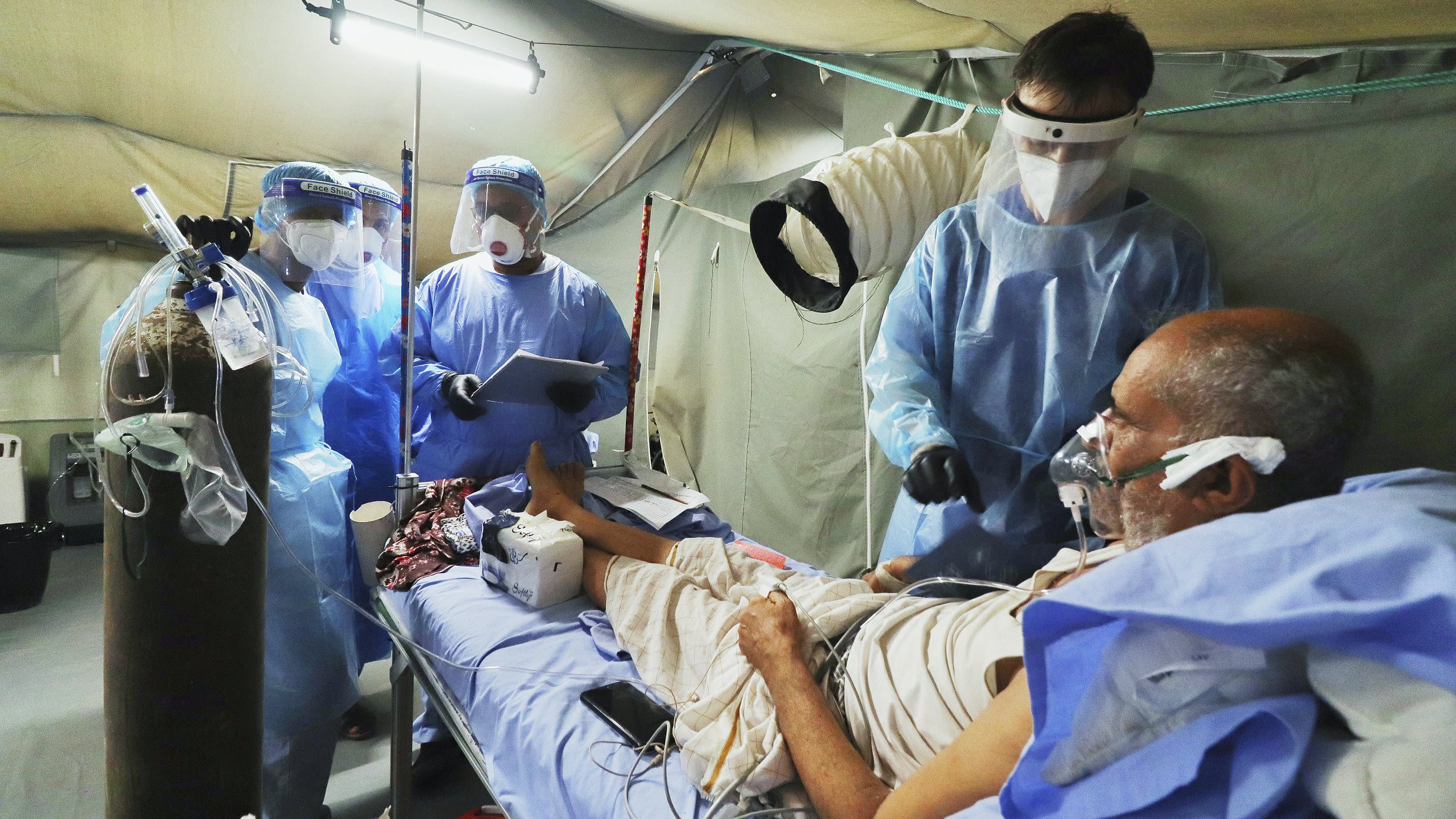
We conducted 11 assessments of the impacts of climate change on livelihoods and/or health in close partnership with the National Societies of (alphabetically) Afghanistan, Ethiopia, Fiji, Kenya, Malawi, Maldives, Mongolia, Myanmar, Nepal, Pakistan and Timor-Leste.
The assessments were aimed at helping these National Societies provide a stronger focus on health in discussions on National Adaptation Plans and reduce health risks induced or exacerbated by climate change; they dovetail with the IFRC’s Strategy 2030 and several other IFRC frameworks.
Strengthening the climate resilience of health systems emerged from this work as essential to adaptation; this was also a major theme of the World Health Organization at COP26, along with research on health-related adaptation.
A brief published jointly with the IFRC detailed the adverse impacts of climate change on human health, providing more detail on what is the second of four pillars of action in Movement ambitions on climate, to “systematically integrate climate risk management across our health programmes and anticipate the health-related consequences of climate change and environmental degradation”.
The Maldives Red Crescent was one of 11 National Societies that took part in an IFRC-Climate Centre research programme on climate, health and livelihoods. (MRC)
The Maldives Red Crescent was one of 11 National Societies that took part in an IFRC-Climate Centre research programme on climate, health and livelihoods. (MRC)
We partnered with the UK Health Security Agency and the Adaptation Research Alliance in a consultation to identify research priorities to strengthen and adapt the climate resilience of health systems globally.
This report was showcased at the launch of the ARA at COP26, where many sessions focused on health, including two jointly organized by the IFRC with the UK, Finland, the Finnish Red Cross and the Climate Centre.
In the run-up to the UN climate talks, our health team published preliminary results from research showing that only just under 2 per cent of total funding in a decade of climate adaptation finance goes to health-related work.
Our work on infectious diseases affected by climate change, such as dengue fever in Barbados, was also presented at the Global Dialogue Platform.
The health team has additionally joined a large consortium of academic institutions in Europe, IDAlert, funded by the European Commission, which will develop seasonal indicators of vector- and water-borne diseases.
Climate and conflict
‘Despite the progress we have made, the world is in turmoil. Three C’s are threatening us right now:
Covid-19, climate change, conflict’
– Jagan Chapagain, IFRC Secretary General (at the 11th European regional conference, April 2022)
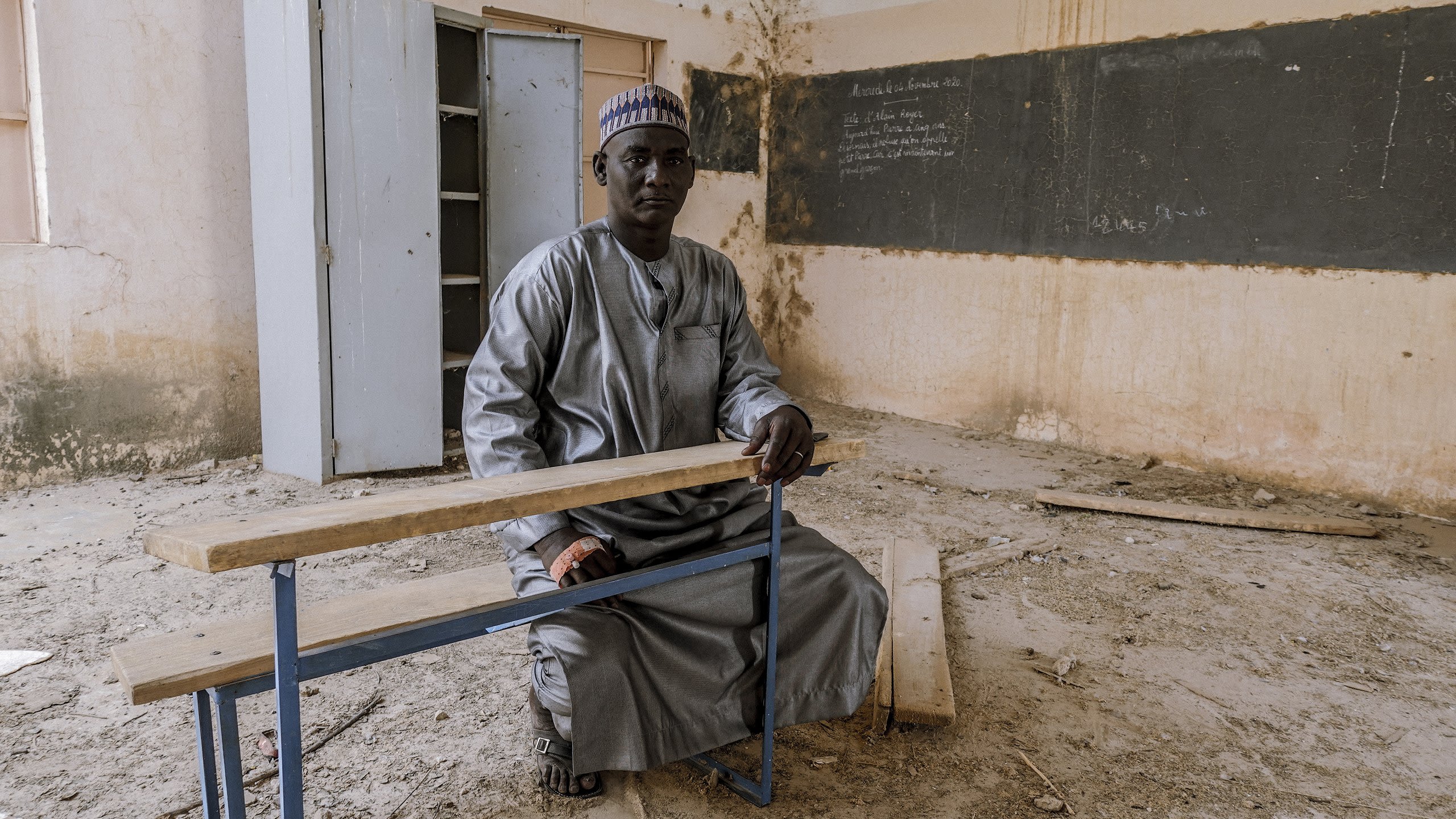
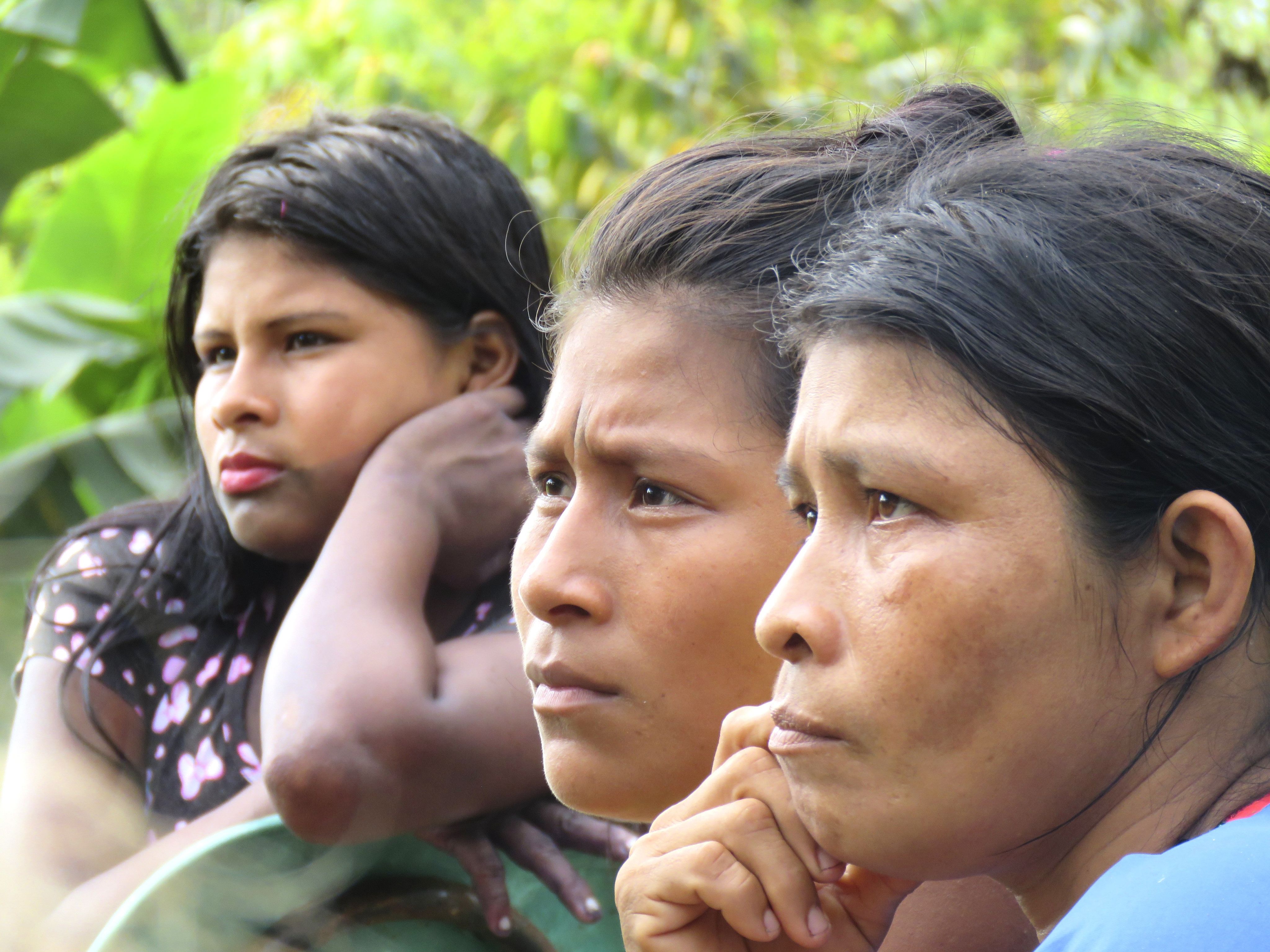
Women in Colombia’s Antioquia department listen to ICRC delegates during a visit last year to an indigenous community isolated by conflict. Colombia was one of 12 countries where the Climate Centre was providing direct support to the ICRC on local climate impacts in 2021. (Ricardo Monsalve Gaviria/ICRC)
Women in Colombia’s Antioquia department listen to ICRC delegates during a visit last year to an indigenous community isolated by conflict. Colombia was one of 12 countries where the Climate Centre was providing direct support to the ICRC on local climate impacts in 2021. (Ricardo Monsalve Gaviria/ICRC)
During 2021 our work on the intersection between climate and conflict gained momentum with collaborations with the ICRC, the World Bank and research partners. We explored climate and conflict in our podcast Can’t Take the Heat, for example, and in our session at the Planet:Red Summit.
The Climate Centre provided the ICRC with extensive support to its Plan of Action to implement the Climate and Environment Charter for Humanitarian Organizations.
We screened climate-risk for at least 11 ICRC delegations, providing recommendations for climate-smart programming, and mapped key stakeholders, also publishing more than 20 national and five regional fact-sheets for capacity building.
This underpinned plans for climate action by delegations, and some recommendations have already been adopted in programmes: for example, beekeeping livelihoods projects in Syria now prepare beekeepers for hotter drier conditions.

Women in Colombia’s Antioquia department listen to ICRC delegates during a visit last year to an indigenous community isolated by conflict. Colombia was one of 12 countries where the Climate Centre was providing direct support to the ICRC on local climate impacts in 2021. (Ricardo Monsalve Gaviria/ICRC)
Climate Centre staff – in person and remotely – are providing technical support on specific initiatives for ICRC delegations in (alphabetically) Burkina Faso, the Central African Republic, Colombia, Jordan, Kenya, Iraq, Myanmar, Niger, Palestine, Syria, Ukraine and Yemen.
Building on general training sessions on climate, we have developed short workshops on climate robustness aimed at helping ICRC delegations and National Societies get the measure of the climate risks their regions face, stress-test projects for such risks, and identify follow-up actions; the Burkina Faso delegation was the first to do the workshop.
During the VICE Creators Summit on “futures for a habitable planet”, the Climate Centre offered innovative engagement to advance global awareness on the intersections between climate and conflict, supporting events run by the ICRC’s Asia-Pacific and Latin America regions, including a memes and cartoons.
As anticipatory action in the context of conflict gains relevance, we established a specialist group for the Anticipation Hub and jointly organized a two-week training for NGOs, together with the German Red Cross and the German Global Public Policy Institute, convened by the University of Bochum.
With the Sudanese Red Crescent and with the support of the Danish and German Red Cross, and in consultation with the ICRC, we mapped the way IDPs and refugees were exposed to both droughts and floods.
With the World Bank in Burundi we developed a detailed “hotspot map” to highlight where action and finance on climate could best be directed; this was in partnership with the University of Cape Town, the Netherlands Red Cross 510 team, and the University of Stanford.
Attribution
‘Geert Jan is a hero and an incredible scientist’
– Erin Coughlan de Perez, Manager, Climate Science,
Climate Centre
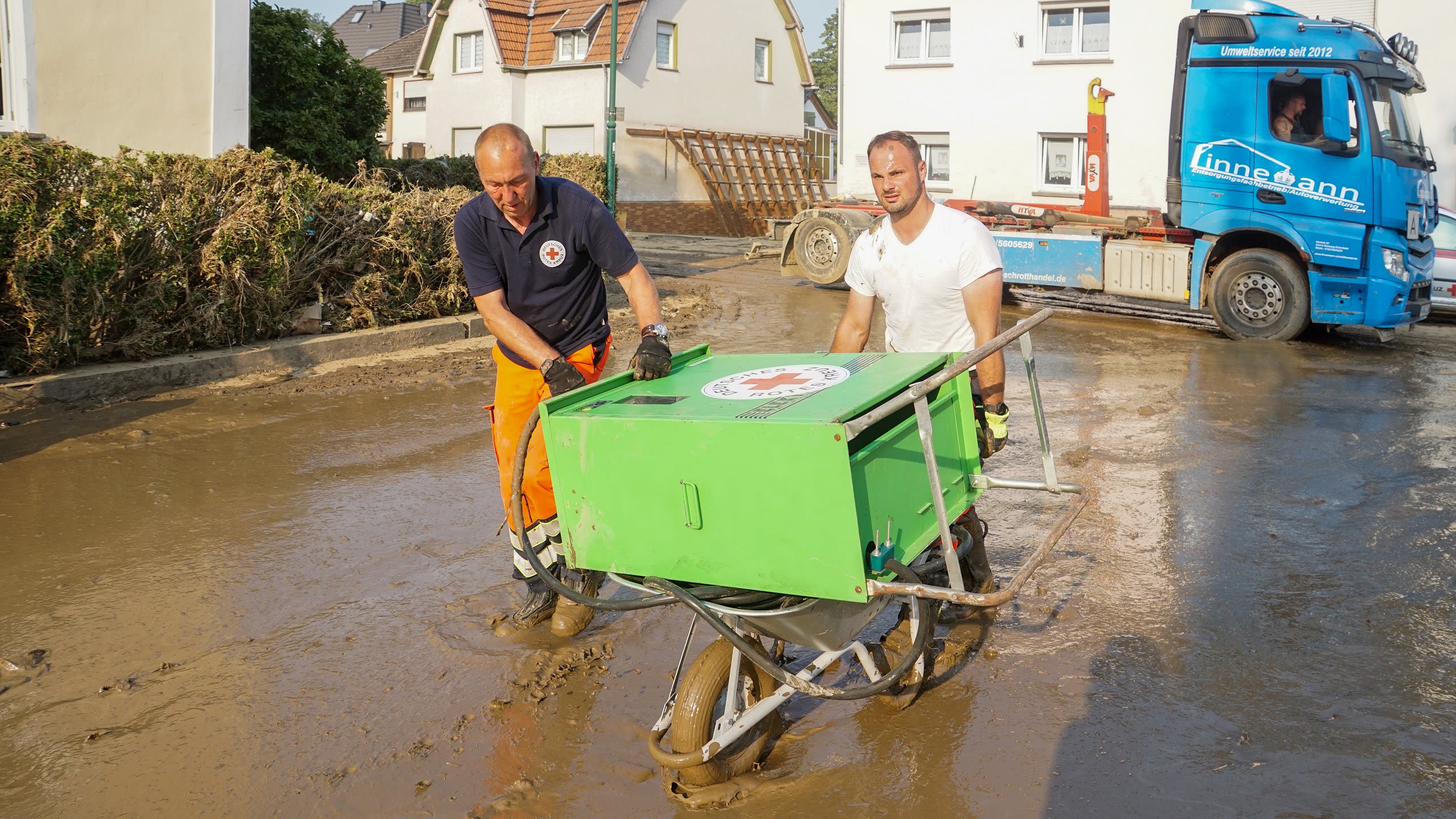
In 2021 the Climate Centre contributed to a number of high-profile analyses of the role of climate change in extreme-weather events as part of the World Weather Attribution group.
We very sadly lost one of the founders of the WWA initiative: the Dutch meteorologist Geert Jan van Oldenborgh, renowned for being the driving force behind the relatively new science of climate attribution itself. A brilliant scientist, a fierce advocate for making science accessible to society, and a wonderful friend to many, he is sorely missed.
In what was a summer of disasters in the northern hemisphere, the group found the June North American heatwave would have been virtually impossible without climate change.
The episode included an extraordinary Canadian record of 49.6ºC in the village of Lytton that was later destroyed by a wildfire, far above the previous record of 45ºC, and generally caused deaths, serious damage to infrastructure and economic losses.
Again in June, climate change increased the probability and intensity of the exceptional rainfall in Western Europe resulting in floods that without it might occur about once in 500 years; at their most intense the floods destroyed everything in their path. More than 200 people were killed.
Geert Jan van Oldenborgh climate scientist, 1961–2021, with former Climate Centre colleague Flavio Monjane on a day out from a team meeting. (Erin Coughlan de Perez/Climate Centre)
Geert Jan van Oldenborgh climate scientist, 1961–2021, with former Climate Centre colleague Flavio Monjane on a day out from a team meeting. (Erin Coughlan de Perez/Climate Centre)
The group also concluded that factors other than climate change were the main drivers of the food-security crisis in Madagascar: this was “made significantly worse by well below average rainfall from July 2019 to June 2021 [in] a region with high pre-existing levels of vulnerability to food insecurity, and the impacts have been compounded by Covid-19 restrictions and pest infestations.”
The team said their findings were consistent with an earlier IPCC conclusion that “any perceptible changes in drought would only emerge in this region if global mean temperatures exceed 2°C above pre-industrial levels.”
The XAIDA project on using artificial intelligence for detection and attribution got underway in September, with the Climate Centre facilitating a game on using attribution science for decision-making. Our role was to facilitate interactions with humanitarian stakeholders and inspire collaboration on connecting the science to adaptation.
Social protection
‘Leveraging climate finance means, first, making universal social protection the main backbone of climate aid’
– Hugo Slim, senior research fellow at Oxford University and former ICRC head of policy, 25 October op-ed
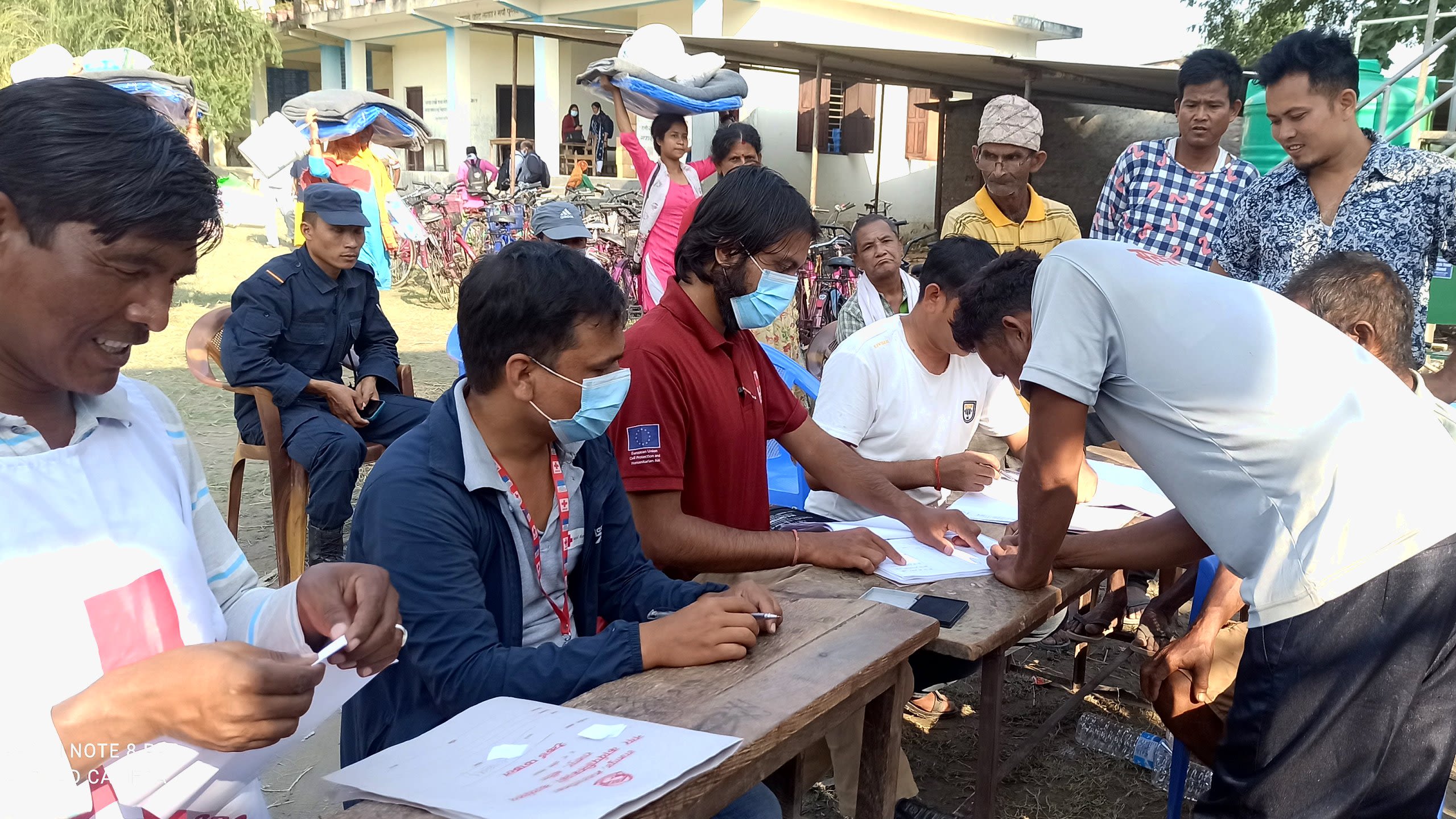
Early last year the Climate Centre published four briefs exploring how existing social protection systems could be expanded or modified, given adequate resources, to become more responsive to shocks.
Another brief, jointly authored by Climate Centre and other experts, incorporating social protection responses to Covid-19, argued for “large-scale risk-management systems … to protect livelihoods, property, and lives in response to the accelerating impacts of environmental change.”
Working closely with the anticipation team as part of the UK Met Office’s Asia Regional Resilience to a Changing Climate programme, research was conducted to hypothetically test the potential of scaling up social protection as an early action measure to reduce hazard impacts, based on past Nepalese experience.
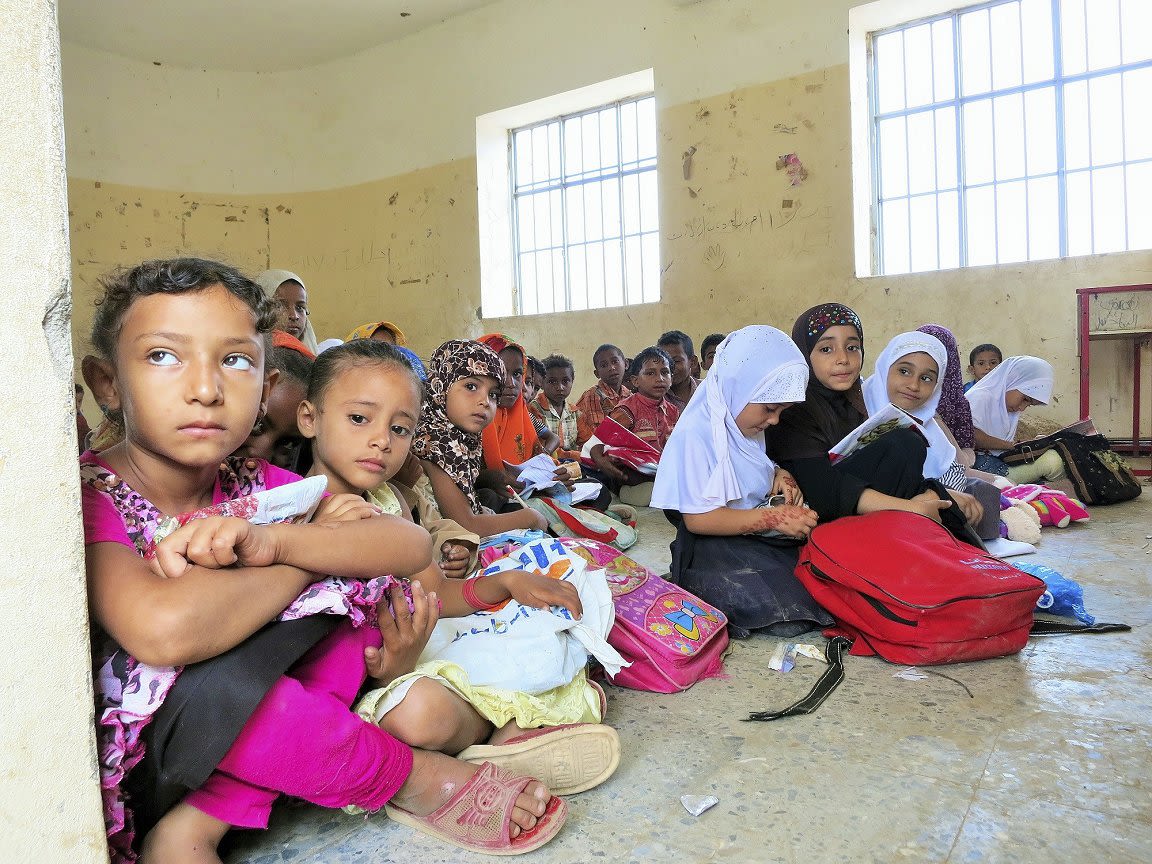
A school in Wusab Assafil district, Yemen, a country often seen as being at the core of the climate and conflict nexus. Hugo Slim argued last year for a pivot “from war aid to climate aid”, with universal social protection the backbone of climate aid. (Qusai Almoayed/ICRC)
The Danish Red Cross also supported the Nepal Red Cross Society in providing emergency cash support in two flood-affected municipalities, Kailali and Bardiya, by leveraging Nepal’s existing Social Security Allowance programme; our technical advice helped the societies identify entry points for linking SSA components to forecast-based action.
A dialogue started in 2020 by the Climate Centre on bringing social protection into policy, projects and advocacy came to fruition when a working group was formally constituted under the auspices of the Social Protection Inter-Agency Cooperation Board and the Global Partnership for Universal Social Protection to Achieve the Sustainable Development Goals.
The working group is currently being led by the International Labour Organization and the Climate Centre and incudes development agencies from France, Germany and the UK.
In October 2021, the Climate Centre, the German Development Institute, and ActionAid jointly authored an advocacy brief looking at gaps in policy on implementing social protection related to loss and damage, and outlining areas for relevant capacity-building in the global South.
A feasibility study in Lesotho on social protection that’s responsive to shocks was finalized as part of a larger package of support to Lesotho Red Cross Society on FbF; a similar study was initiated for Bangladesh.

A school in Wusab Assafil district, Yemen, a country often seen as being at the core of the climate and conflict nexus. Hugo Slim argued last year for a pivot “from war aid to climate aid”, with universal social protection the backbone of climate aid. (Qusai Almoayed/ICRC)
A school in Wusab Assafil district, Yemen, a country often seen as being at the core of the climate and conflict nexus. Hugo Slim argued last year for a pivot “from war aid to climate aid”, with universal social protection the backbone of climate aid. (Qusai Almoayed/ICRC)
Youth
‘The climate crisis is our present and our future’
– Isa, 19, the Philippines (quoted in new IFRC-Climate Centre strategy for youth-led climate action)
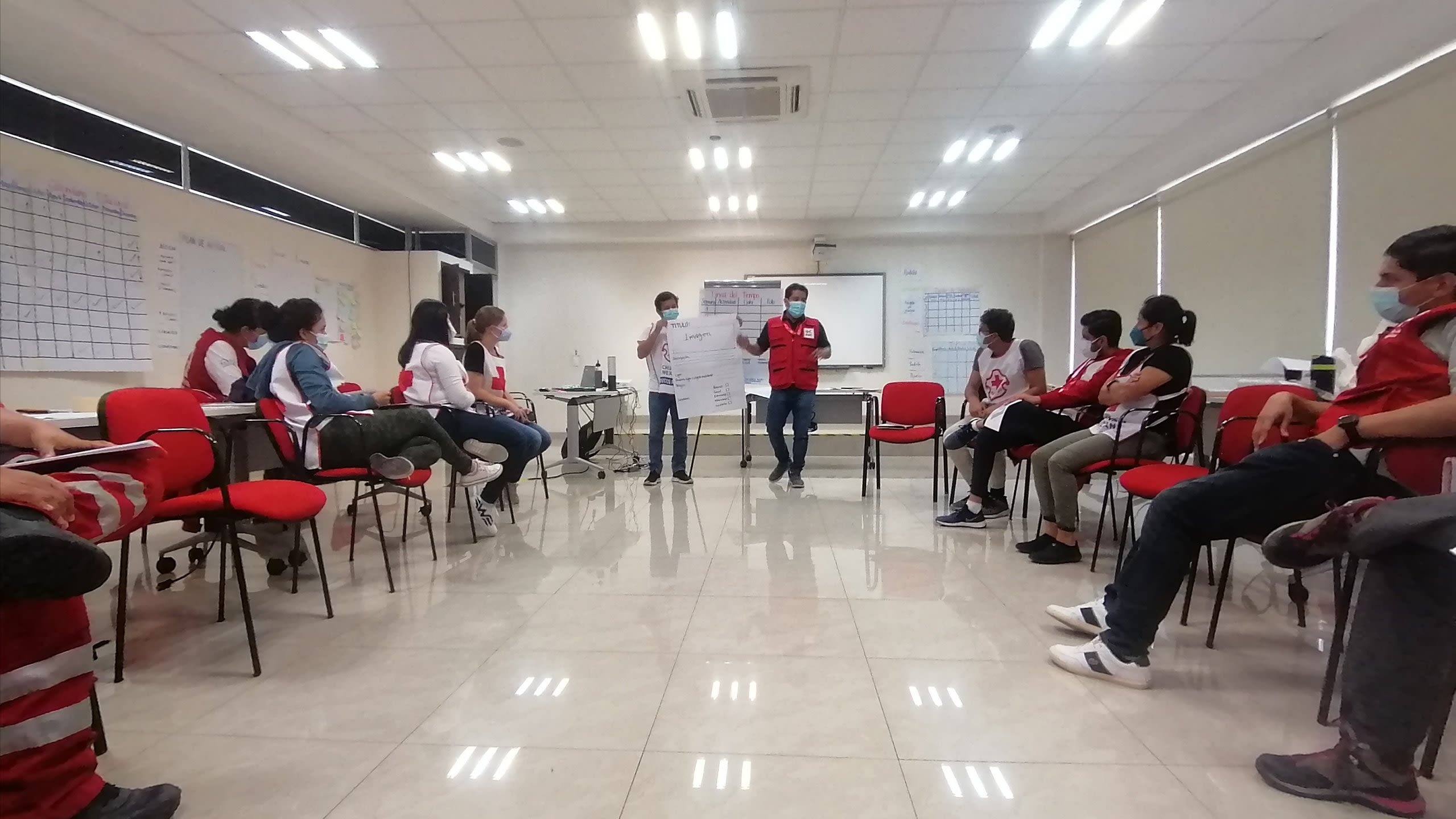
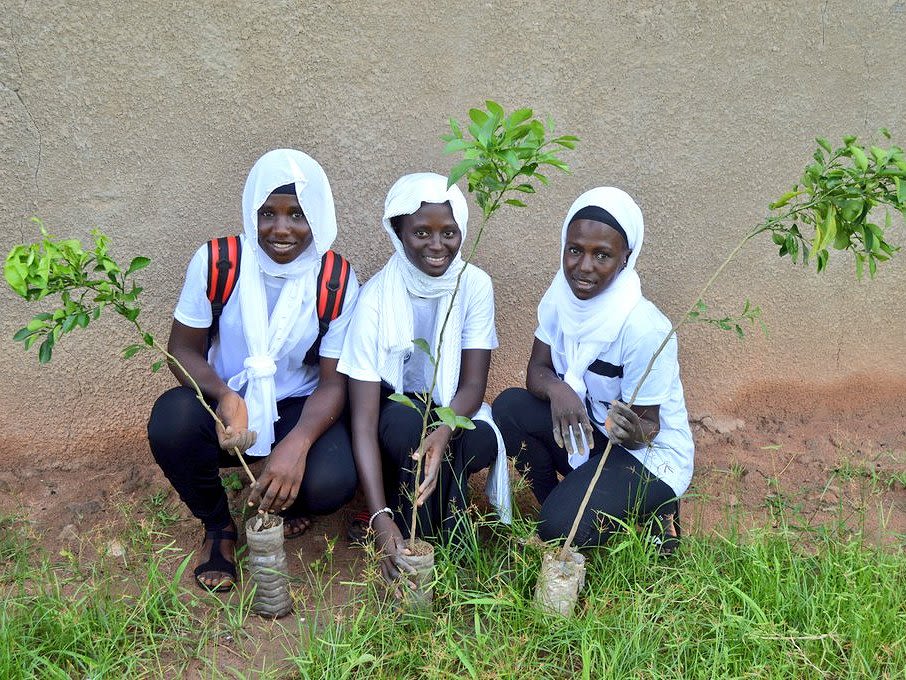
Gambian schoolgirls engaged in a massive nationwide tree-planting exercise – part of the National Society’s work to tackle the impacts of extreme weather. (Gambia Red Cross)
Gambian schoolgirls engaged in a massive nationwide tree-planting exercise – part of the National Society’s work to tackle the impacts of extreme weather. (Gambia Red Cross)
The IFRC and the Climate Centre chose Earth Day 2021 to launch the Red Cross Red Crescent Strategy for Youth-led Climate Action.
It was created both for youth and by youth after consultations, surveys and virtual engagements in English, Spanish, French and Arabic.
In September we jointly hosted the first Red Cross Red Crescent climate and youth summit, opened by IFRC President Francesco Rocca, bringing together young people from nearly 100 National Societies.
During the event we facilitated many youth-led sessions on innovations such as the ‘Disastrous Dinner’ concept from the Australian Red Cross and the Waste Mai Waste project from Thailand – innovations that combine technology and build community preparedness, resilience and knowledge.

Gambian schoolgirls engaged in a massive nationwide tree-planting exercise – part of the National Society’s work to tackle the impacts of extreme weather. (Gambia Red Cross)
Amid ongoing Covid restrictions we continued virtual support to Y-Adapt training, with one highlight being sessions organized by the Mexican Red Cross in September (main photo).
We also started asking National Societies to record their work on adaptation by young people within Y-Adapt on a global map.
Finally, Red Cross Red Crescent youth from at least 50 countries joined the Red Cross Red Crescent youth climate community on Facebook, where examples are shared, input gathered, and relevant events are livestreamed.
Innovation
‘Humorists have this intense ability to notice, to detect the anomaly and then they shed light on that’
– Pablo Suarez, Innovation Lead, Climate Centre
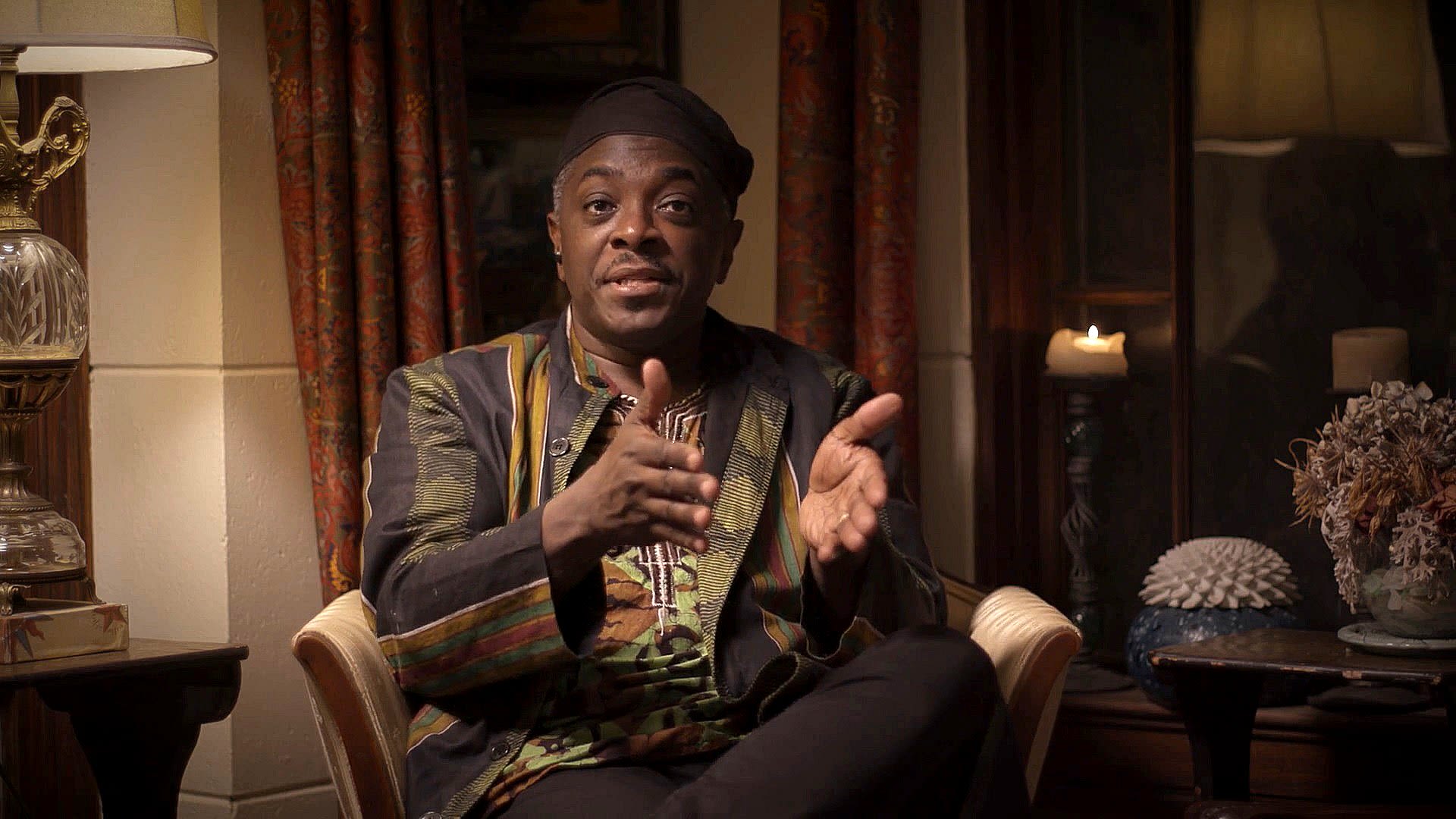
As our world changes at an accelerating pace, the Climate Centre continues to generate innovations that bring humanity to the core of the many climate-related processes shaping our future.
Fully embracing the IPCC’s call for “rapid, far-reaching, and unprecedented changes in all aspects of society,” the Climate Centre champions new and useful approaches to linking climate science, policy, and humanitarian practice. For example, we have scaled up our work with professional humorists to improve risk communication.
National Societies, the ICRC, the IFRC, and partners have embraced our cartoonathon approach: fun but serious visuals to support learning and dialogue. Dozens of events have featured our cartoon innovations.
At COP26 in Glasgow, for example, our cartoon wall, No Joke, featured 60 of the more than 300 climate cartoons we have helped create; also our cartoon-based guide to the IPCC Working Group I report on science was critically acclaimed.
Our leading role in game design for risk management continues to open opportunities, including a collaboration (featured in the New York Times) with game designer Matt Leacock, of Pandemic game fame, to add a humanitarian dimension to the upcoming world-class board game Daybreak.
Creative collaboration with artists has also had impacts. Our two-minute video Should They Stay or Should They Go? (main photo) harnesses the power of a rock and roll classic by The Clash to pose tough questions on displacement.
Dalí Surreal is a minute-long vignette of cardboard theatre depicting a future under extreme temperatures (main video).
We have also charted new territory in climate communication by developing artworks that use a special pigment that changes colour with temperature.
This ThermoChromic Art was featured at London’s Tate Modern and in our video Inspire or Expire, which also includes batik art from Indonesia, beach art from Vanuatu, a song from Togo, a take on the video game Fortnite, a climate twist on J.S. Bach with The Ill-Tempered Clavier, and numerous other ideas conceived with the help of COP26 participants.
As well as ongoing engagement with debates on geoengineering, we are also building on previous technology-enabled, people-centred explorations. Examples include our collaboration with NASA, published in the Journal of Applied Remote Sensing, on integrating Earth observations into flood forecasting.
Virtually Amazing
‘The virtual format ‘provided a unique opportunity for broader and more inclusive participation from around the world’
– UN statement for the 7th Humanitarian Networks
and Partnerships Weeks
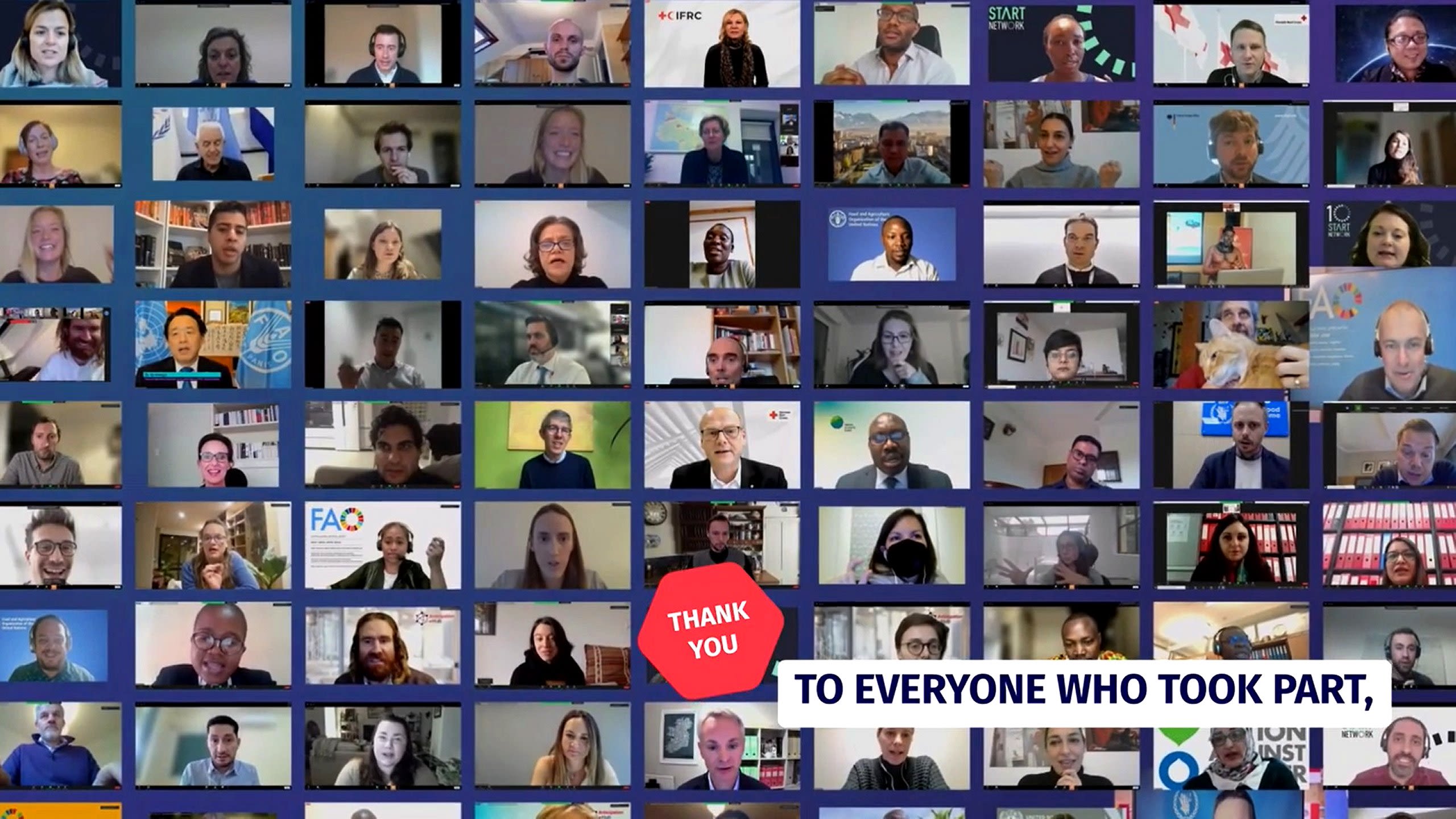
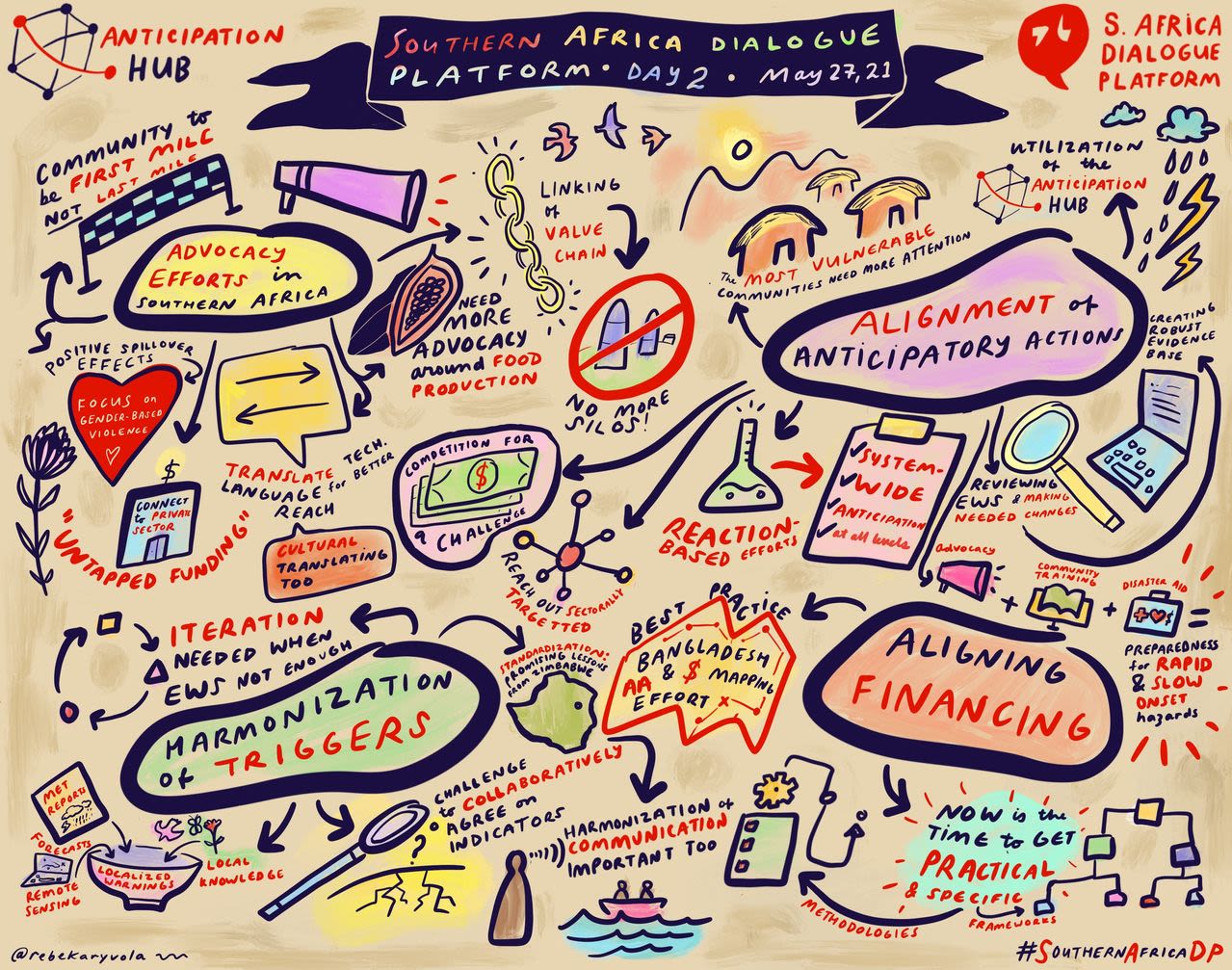
@RebekaRyvola’s graphic take on the first Southern Africa dialogue platform on anticipatory humanitarian action in May 2021
@RebekaRyvola’s graphic take on the first Southern Africa dialogue platform on anticipatory humanitarian action in May 2021
We continued to engage intensively in the virtual space, promoting innovation and virtual interaction to establish new perspectives on linkages between science, policy and humanitarian practice.
With an increased sense of urgency globally and in the Movement, we worked with National Societies in the virtual African Climate Fellowship programme, for example, and at the COP26 UN climate talks.
Virtual engagement was last year the main form of outreach due to the pandemic, but we also experimented with a series of innovative hybrid events that included some face-to-face interaction.
We continued to bring innovation to the urban climate agenda, especially in Southern Africa. The final FRACTAL ‘mega lab’, for example, brought together stakeholders from Cape Town, Lusaka, Maputo and Windhoek to engage both in person and virtually.
We facilitated virtual training courses with partners such as those involved in the Enhanced Vulnerability and Capacity Assessment training for Africa, other training sessions on impact-based forecasting in Nepal, and the virtual African Climate Fellowship programme, including virtual graduation ceremonies.

@RebekaRyvola’s graphic take on the first Southern Africa dialogue platform on anticipatory humanitarian action in May 2021
The African Climate Fellowship programme used our engaging and interactive virtual processes to forge a new basis for climate action within the Movement for at least 15 National Societies in Africa, in both English and French.
We also developed a virtual climate-training course, building on the crowdsourced expertise of specialists in climate, advocacy, resilience and disaster management from National Societies, the IFRC secretariat, the Climate Centre and Zurich Flood Resilience Alliance partners.
We promoted new virtual tools, games and cartoon-based processes throughout the year. We designed interactive and innovative engagement for international conferences such as Humanitech Summit 2021, RISE Africa 2021, and dialogue platforms on anticipatory action in Africa, Asia and Latin America.
The Virtually Amazing team designed and facilitated policy-related events in the run-up to COP26 in Glasgow and hosted a virtual edition of Development and Climate Days alongside it, featuring interactive cartoon-based sessions.
In 2021 the Climate Centre team added solid process-design skills, as well as the innovative and interactive tools that facilitate the complex dialogues crucial to addressing the climate emergency.
Communications
‘Adaptation must be disruptive’
– Clare Shakya, IIED Climate Change Director, message to the 12th Petersberg Climate Dialogue
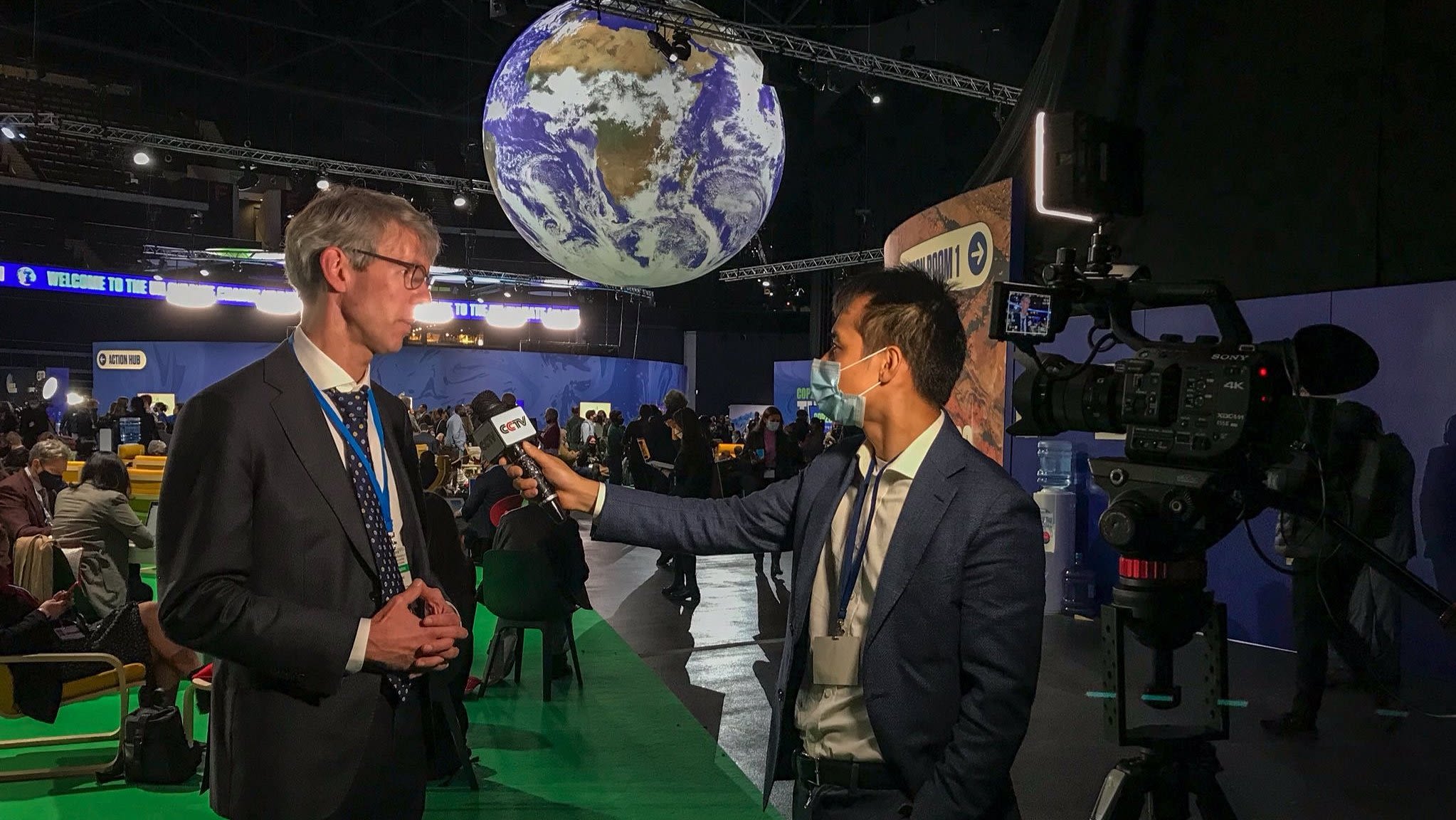
Our social-media audience continued to expand apace in 2021 across Twitter, where it’s fast approaching 10,000 followers, as well as Facebook and LinkedIn.
Two major 2021 studies by the World Weather Attribution group, of which the Climate Centre is a part, received widespread media coverage: the floods in north-west Europe and the North American heatwave, both of which were found to have been made more likely by climate change.
We coordinated our communications output and messaging for all the major climate-related events of the year with the IFRC secretariat, including the UN ECOSOC Humanitarian Affairs Segment, at which its Director of Disasters, Climate and Crisis Pascale Meige said the IFRC was committed to scaling up anticipatory action “so that it reaches more people, covers more locations, and is applied to a wide range of hazards,” as well as the IPCC Working Group I report on science, the Movement’s first-ever youth-led climate summit, and COP26 in Glasgow.
One of our biggest communications successes of the year came with our cartoon interpretation of the WGI findings for humanitarians (see also Innovation and Virtually Amazing).
In a major statement to the US Senate Committee on Homeland Security and Governmental Affairs, which we covered as a news story, the American Red Cross Vice-President for Disaster Programmes, Jennifer Pipa, described climate change as “a worldwide humanitarian emergency – and a defining threat of the 21st century”.
In his first opinion piece of the year, Climate Centre Director Maarten van Aalst argued that ambitions on climate were “exclusively framed around the reduction of greenhouse gas emissions,” but the challenge was to generate similar global momentum on adaptation.
In an interview with Geneva Solutions later, he said many humanitarian donors are now open to providing financial aid before a disaster happens, and while Covid has accelerated the trend funding needed to be more flexible.
As a leading climate spokesperson for the Movement, Professor Van Aalst’s media profile encompassed a huge range of retail media outlets over the course of the year via news agency interviews and institutional press releases.
His one-on-one media engagement in 2021 included Dutch national radio and television, the Associated Press, the BBC, Bloomberg, CCTV, CNN (including CNN Asia), Deutsche Welle, Devex, the Economist, the Guardian, LBC radio (London), Reuters and the Thomson Reuters Foundation, RTL (Netherlands), and more.
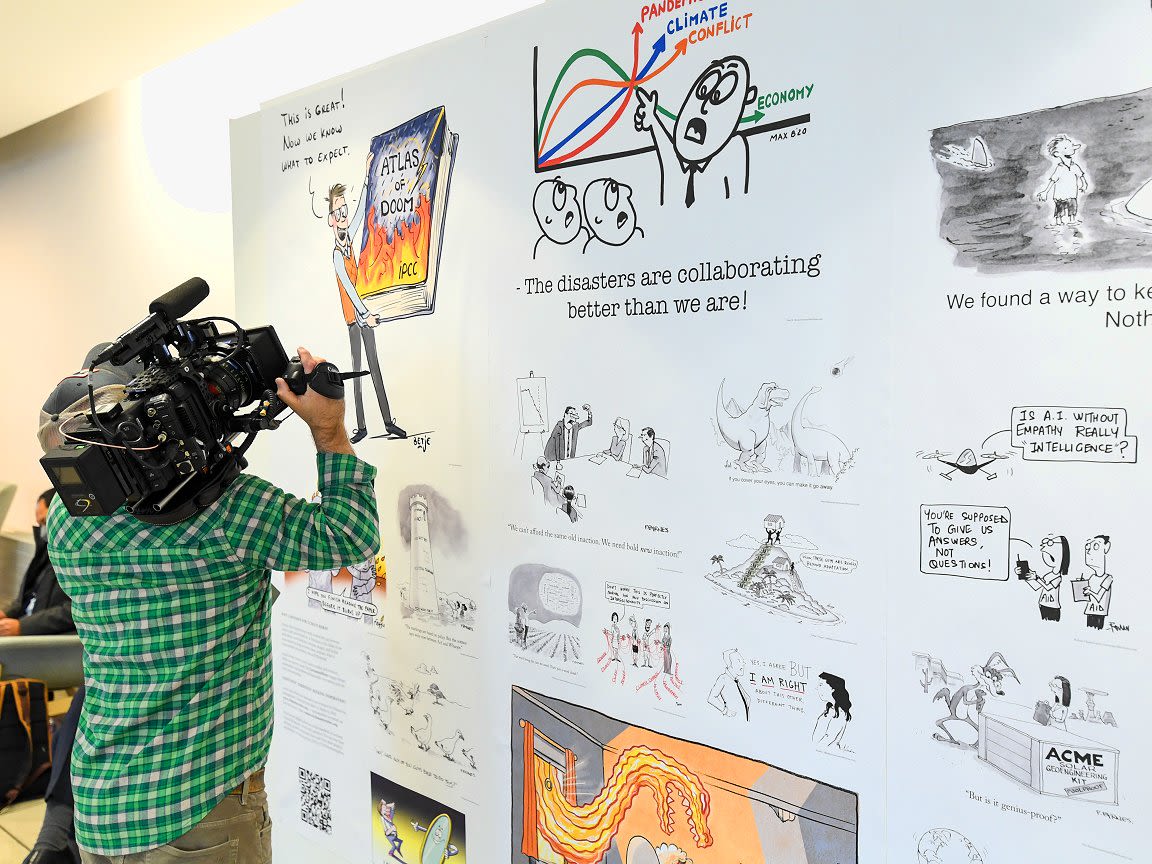
The Red Cross Red Crescent cartoon wall was a big hit at COP26. (Doug Peters/UK government)
The Red Cross Red Crescent cartoon wall was a big hit at COP26. (Doug Peters/UK government)
Finance
The Climate Centre – an independent foundation under Dutch law – remains grateful to its hosts, the Netherlands Red Cross in The Hague, which also assists with human resources and legal affairs.
We were supported last year by the European Commission, the ICRC and the IFRC secretariat, and these National Societies, in each case with the financial support of their governments’ foreign or development ministries (alphabetically):
American Red Cross
Australian Red Cross
Belgian Red Cross
British Red Cross
Danish Red Cross
Finnish Red Cross
French Red Cross
German Red Cross
Netherlands Red Cross
Norwegian Red Cross
Swedish Red Cross
Swiss Red Cross
Other contributors were (alphabetically):* Atlantic Council, Carnegie Climate Geoengineering Governance Initiative, Climate-KIC/EIT, Cordaid, the Food and Agriculture Organization, German Agency for International Cooperation, ICLEI, IKEA Foundation, Institute for Research for Development (France), International Institute for Environment and Development (UK), KPMG, Mercy Corps (US), Met Office (UK), NASA, the National Centre for Scientific Research (France), OCHA, Open Society Institute, Overseas Development Institute (UK), SouthSouthNorth, Stichting Deltares (Netherlands), Tetra Tech ARD (US), the United Nations Environment Programme, World Bank, World Food Programme, World Resources Institute.
We are also grateful for contributions from the Universities of Bristol, Cape Town, Lisbon, Reading, Ruhr-Uni Bochum, and Stockholm, while the American, Netherlands and New Zealand Red Cross funded or shared staff with us.
A full financial statement will be available in our hard-copy report shortly.
As always, we thank all our donors for their generous support.
*Some agencies are best known by their acronyms.

